It was planned to have a last lush 7-day cruise to the far away Island of Anholt in the middle of the Danish-Swedish Kattegat to conclude the 2017 sailing season with a nice little “big bang”, but as it is normal with being outside in a boat and a subject to the mighty forces of nature, it turned out to be a very, very different voyage for sure. My sailing mate – a professional seafarer and passionate about sailing since his childhood – and I boarded a Beneteau First 30 two days ago in the Germany´s northernmost City of Flensburg and sailed north, full of plans. (read about the first leg of our trip here)
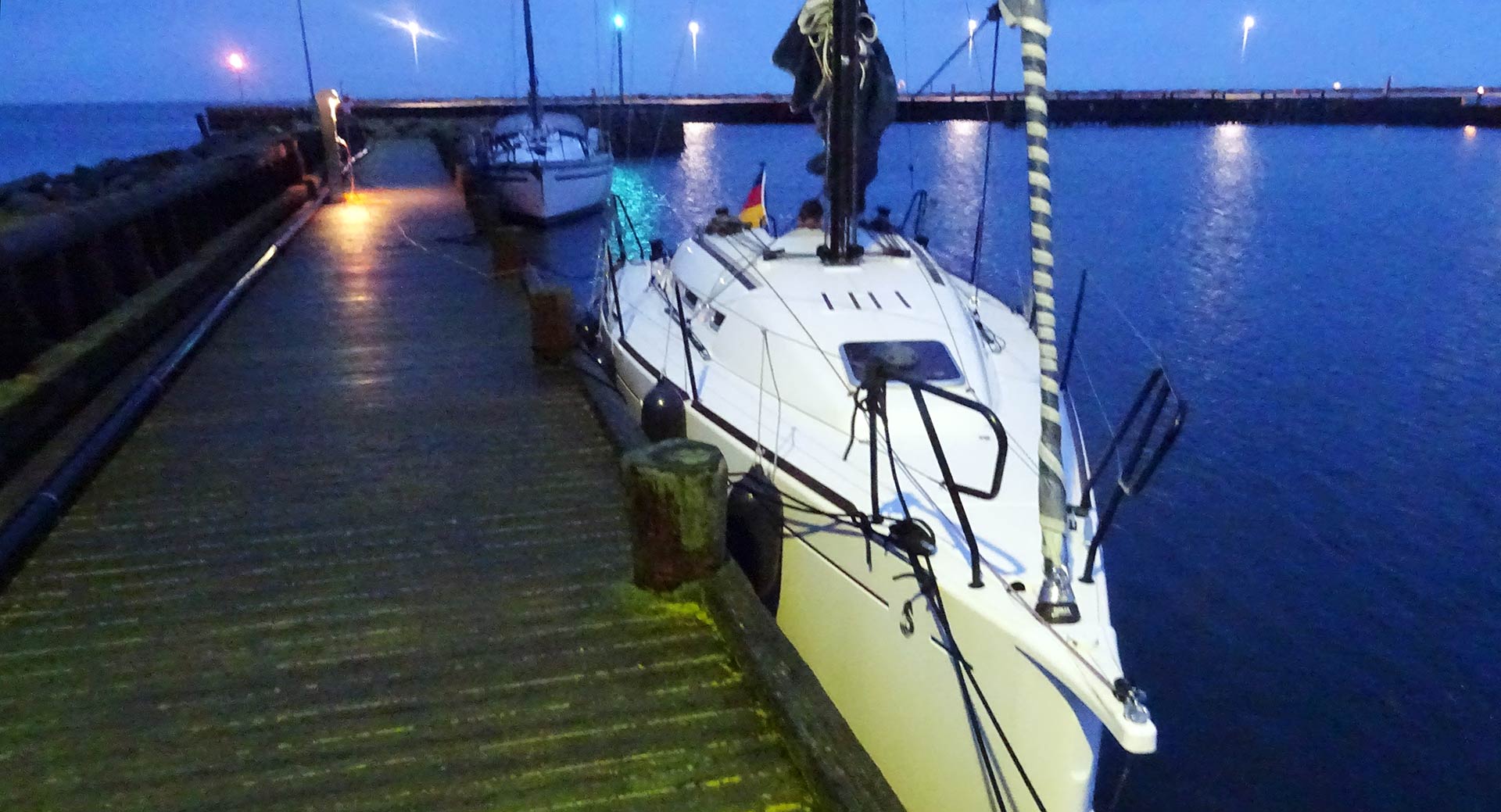
Due to my health condition – I did have a dolorous periostitis in my right arm – I cancelled the plan to sail that far north because I felt I wasn´t in the shape to manage sailing the boat alone whilst my mate would be off-watch down below. The arm was so much full of pain that I virtually couldn´t use it, let alone grind the winches or even cast off a sheet from the winch in a gust. This limitation was accompanied by a bad weather system approaching Germany from the Atlantic Ocean promising very, very foul weather – of which we had been experiencing the first harbingers just after we set sails. Now we arrived at the small harbour of Ballen on the Island of Samsö, the northernmost point of our trip. “7 o´clock, Lars”, my mate said through the night: “Time to get up!”
A Storm Approaching – Storm Strategies
Although it was meant to be a holiday and we both were seeking relaxation and relief from the stresses of daily professional life, it was tough to get out of my bunk this early: Yesterday after arriving here in the midst of a long, very violent gust of more than 35 knots with a very dense rain shower we checked – thank God, Denmark has perfect area-wide WiFi! – weather forecasts and felt that we´d have to leave today as early as we could to avoid the worst. “Even more foul weather approaching”, my mate announced.
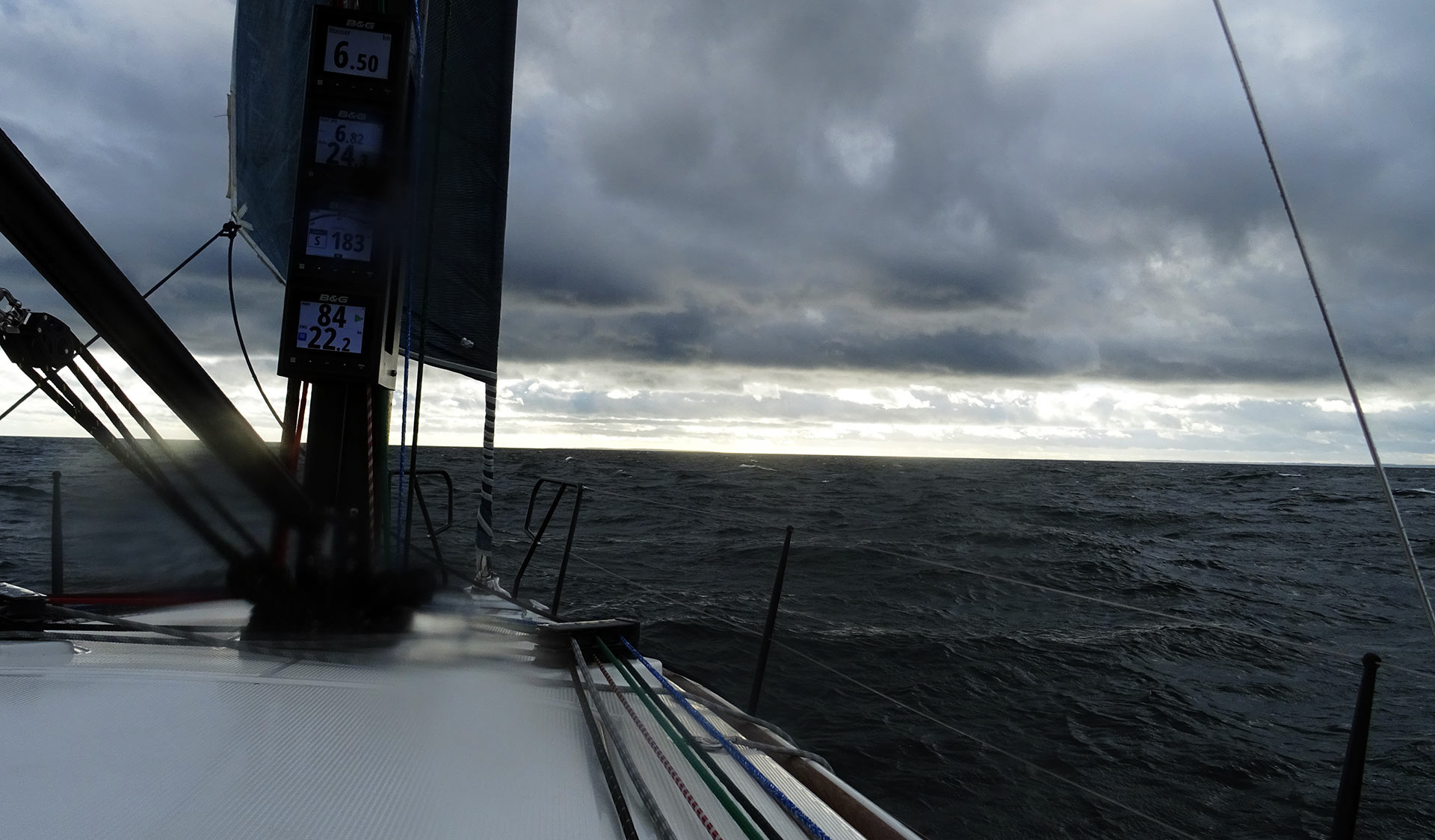
So we just got up, brushed our teeth whilst water was boiling on our one-flamed stove and had a cup of hot steaming coffee. We were in a hurry because today´s leg was one of the longest and the most complicated in terms of weather routing: “Let´s be underway as soon as possible!”, was our motto. Wind was still blowing hard with some 20 to 25 knots and didn´t ease overnight. It has shifted from South to West, which wasn´t very good: Leaving the lee of the Island of Samsö, our yacht was due to go South again to further complete the rounding of Fyn and this would mean the yacht would be exposed to the westerly wind over a distance of some 15 miles of open water: “That´s a fetch of 35 miles for the Westerly from Danish mainland, there will be quite a swell in this area!”, my mate concluded.
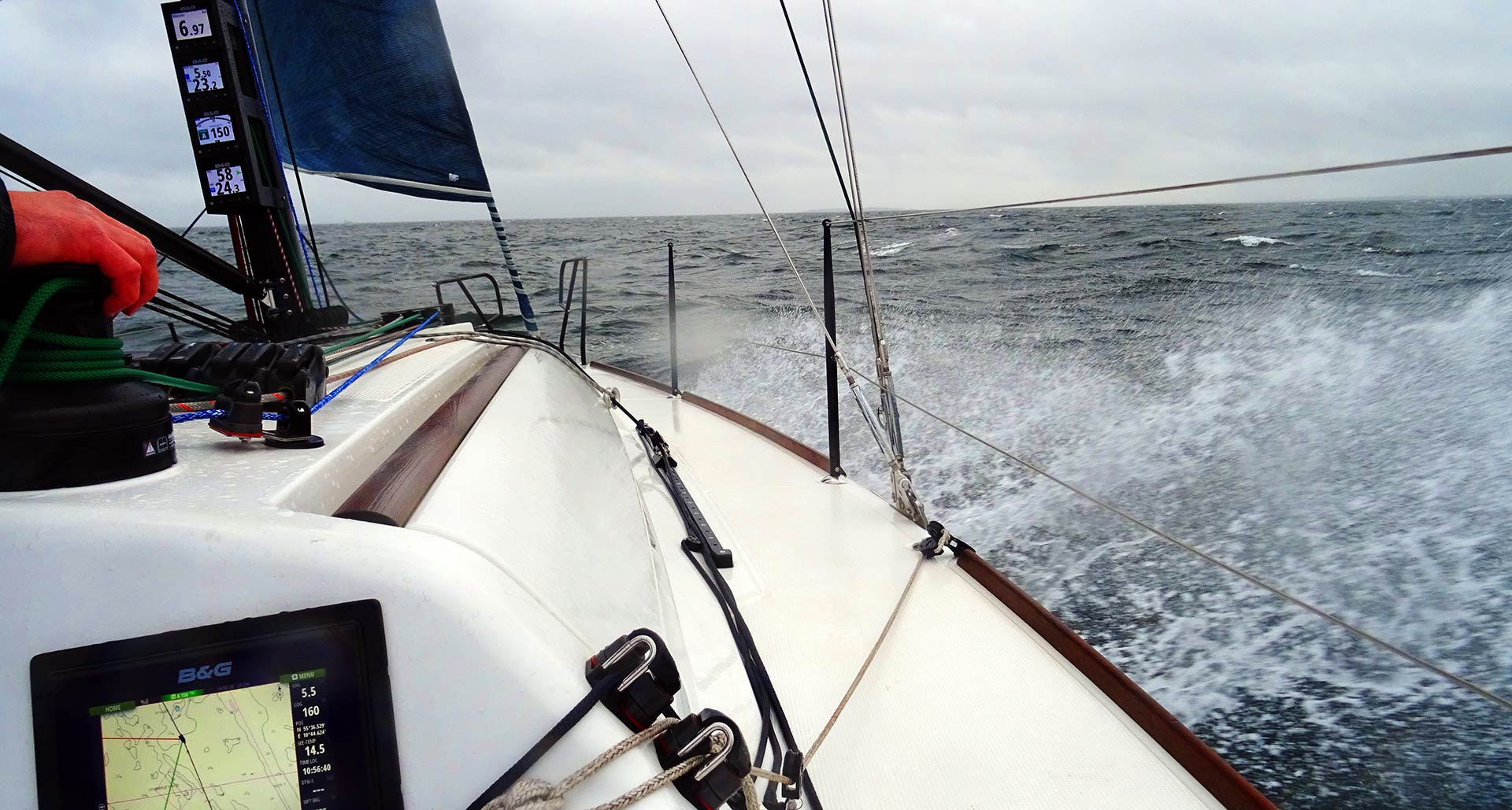
As we left Ballen Havn we really had again been the only yacht still out there sailing, no other boat around. Even the fishermen seemed to be still asleep. We´ve got the engine running at 2.300 rpm and the fore sail out at stormsail-size to act as a stunning sail. The wind came in hard from starboard side and pushed the boat slightly over – but thus also stabilized it in the waves. Being still in the lee of Samsö, those waves of course were nothing compared what would await us some 30 minutes later when we left Samsö lighthouse at the southern tip behind us: “Get the harness up!”, we advised ourselves as the waves began to batter the boat.
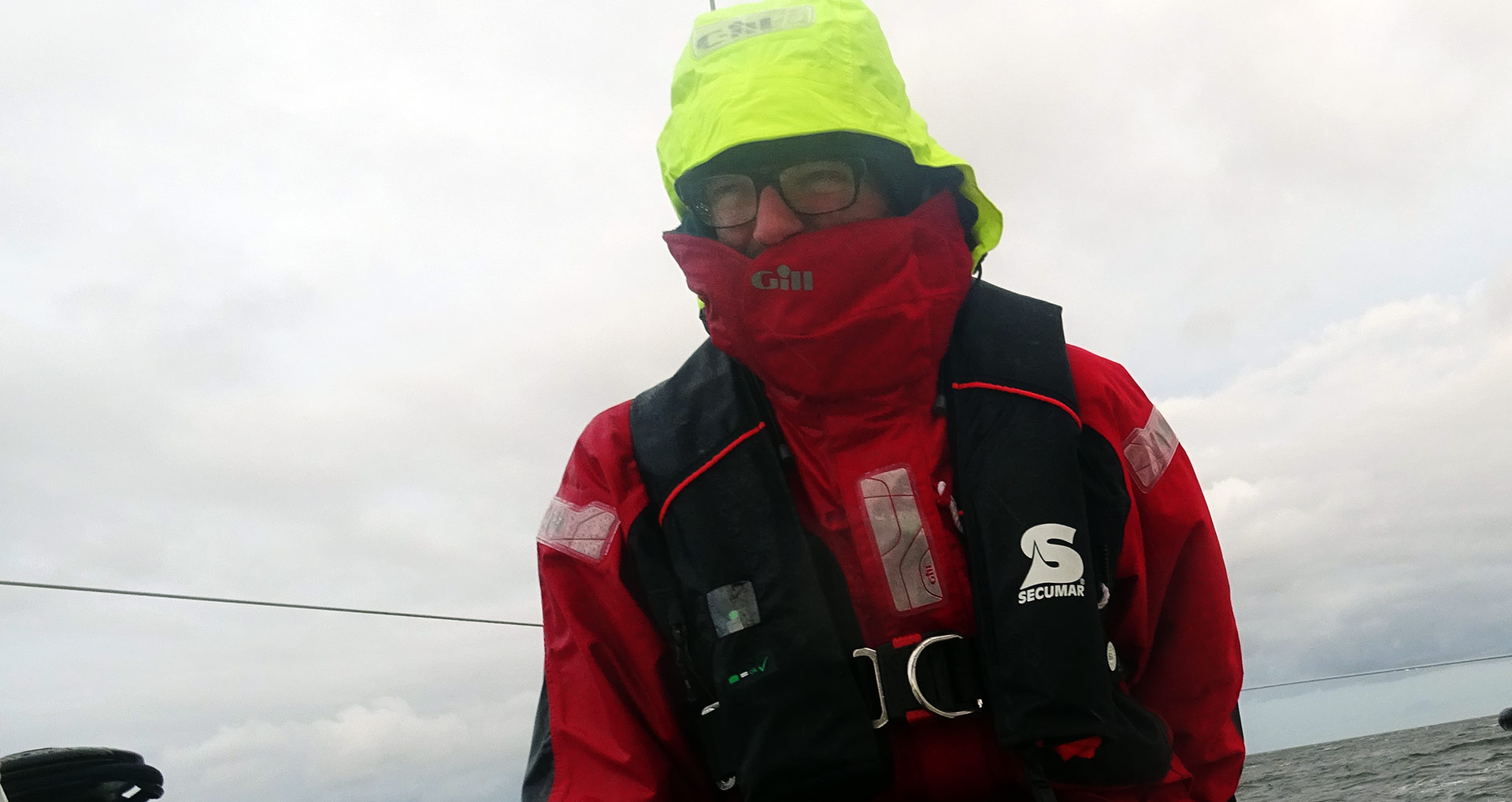
I placed myself at the helm and took over steering right from the beginning as I felt that the automatic steering system wasn´t able to hold a steady course in the swell: “See the waves?”, my mate yelled – and there it was, right in front of us. The sea seemed to be boiling. A criss-cross of waves with sizzling whitecaps was breaking over each other, the seas were intersecting each other here in the shoals and still in the vicinity of the cape. “It´s beginning now!”, my mate shouted and went down to stand inside the boat right in the entryway of the saloon: Unfortunately he somehow didn´t bring his foul weather gear (as a pro sailor he is equipped with the best of the best when it comes to gear) and naturally wanted to postpone getting soaked wet as much as possible. I was happy having – as always – packed my duffel bag with all foul weather gear I own including a number of thermos-underwear. Freezing and shivering wasn´t a nice prospect.
Sailing in Bad Weather
Our small Beneteau First 30 was shaking heavily and rolling in the waves like a small toy boat. Having an overall length of just 9.99 meters the incoming waves of an average height of 1.60 meters didn´t need much effort to cause serious trouble for the boat. With every wave hammering at our broadside the boat was pushed off course. I had to react very quickly at the helm to lay rudder – sometimes hard rudder – to hold the boat onto its designated course. Soon my left arm (since I couldn´t use the right one) was aching, but there wasn´t much choice.
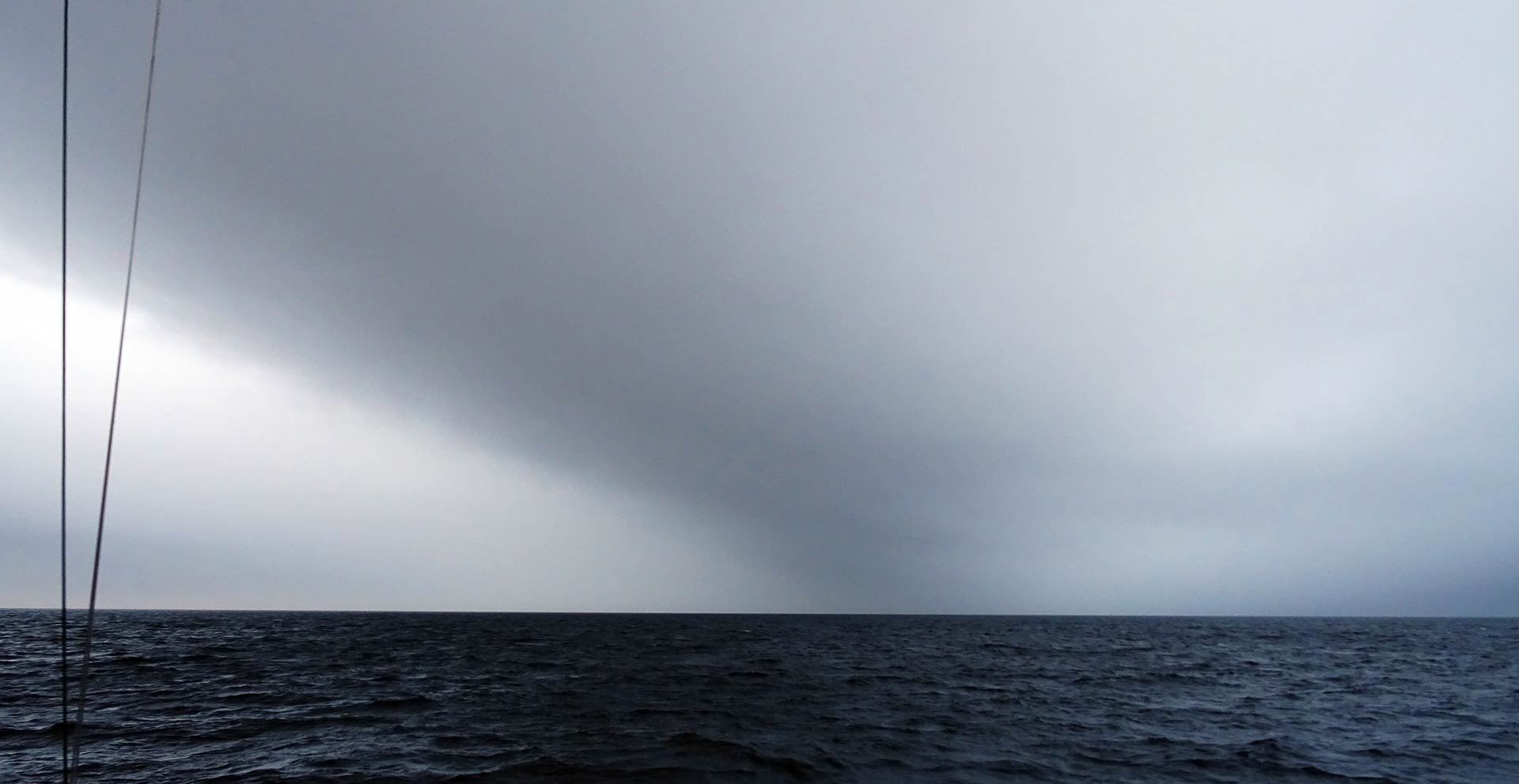
The worst waves came from behind, were rolling down under the hull and overtaking us. When the wave reached the rudders, for a short second the speed of the “overtaking” water was faster than ours and thus the rudder blades simply didn´t had any effect – I lost control over the boat. If now a succeeding wave came in from a slightly different angle, it was able to simply push the boat so violently off course that the danger of broaching was imminent. On two of such occasions we´ve got a very serious heeling and I really had to hold very, very tight to the tiller to prevent a complete broach in the last moment. “See this black dark formation there?”, my mate shouted: Off to starboard a thin black band of air was coming in fast: “This is what a hard gust looks like. Brace for impact!”
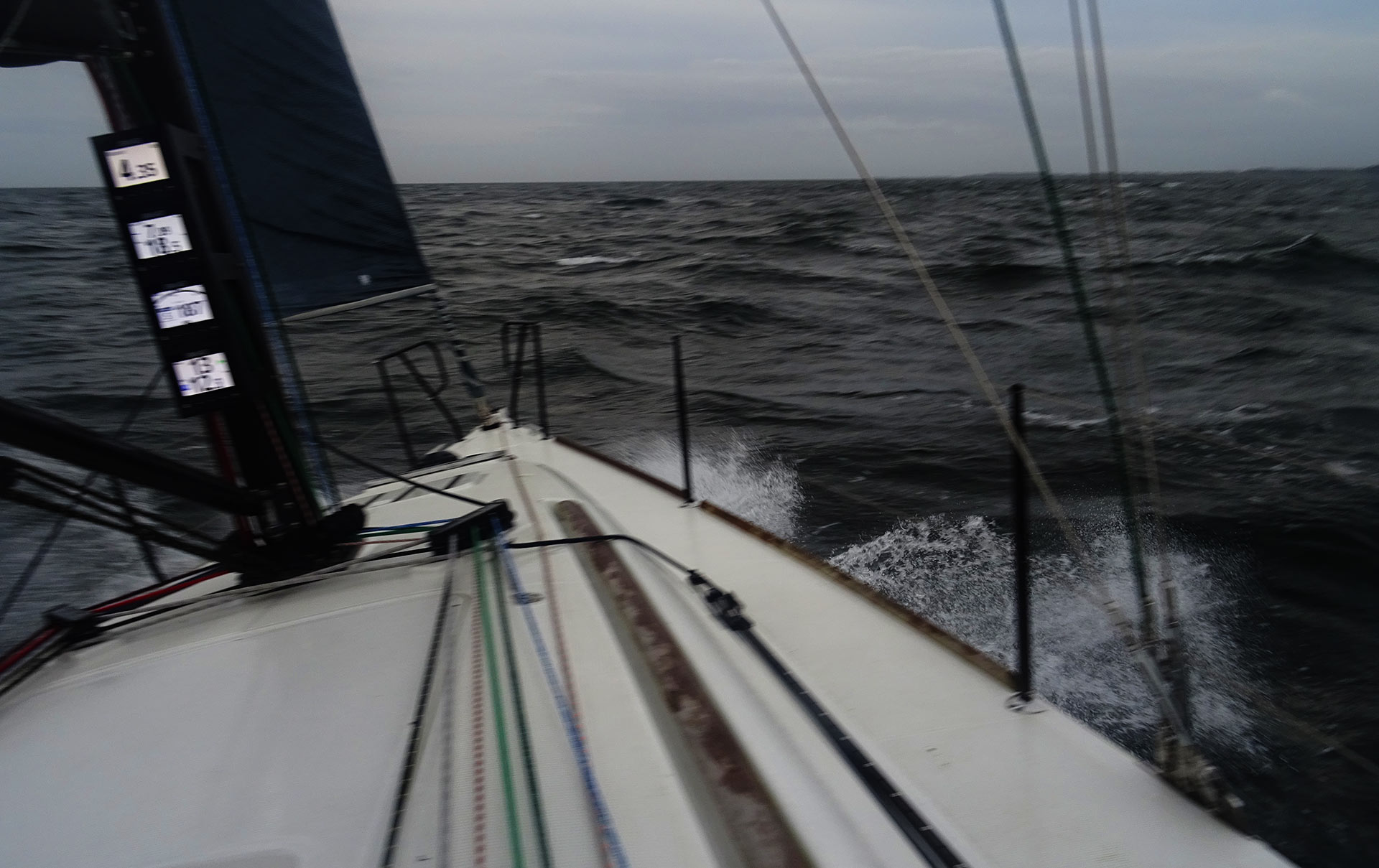
It was fascinating to slowly but surely get accustomed to this kind of sailing. It wasn´t particularly fun to do, but I kind of liked the idea of – for the first time of my life – experiencing a real foul weather situation and to be forced to cope with it full force. Rigging the boat inside and outside to be able to withstand these conditions, learning to “read” the charts in a way as to foresee local wind patterns and behaviour of the waves. Even now, by looking at the sky in the ultimate vicinity was revealing things which were making me able to brace for changes – worse or better – and to react appropriate. As the gust came in, the TWS-screen showed 37 knots. You don´t openly talk about things like this on a boat, but I thought: What if the rudder breaks down now? The engine dies off? Look forward! Hold to your job!
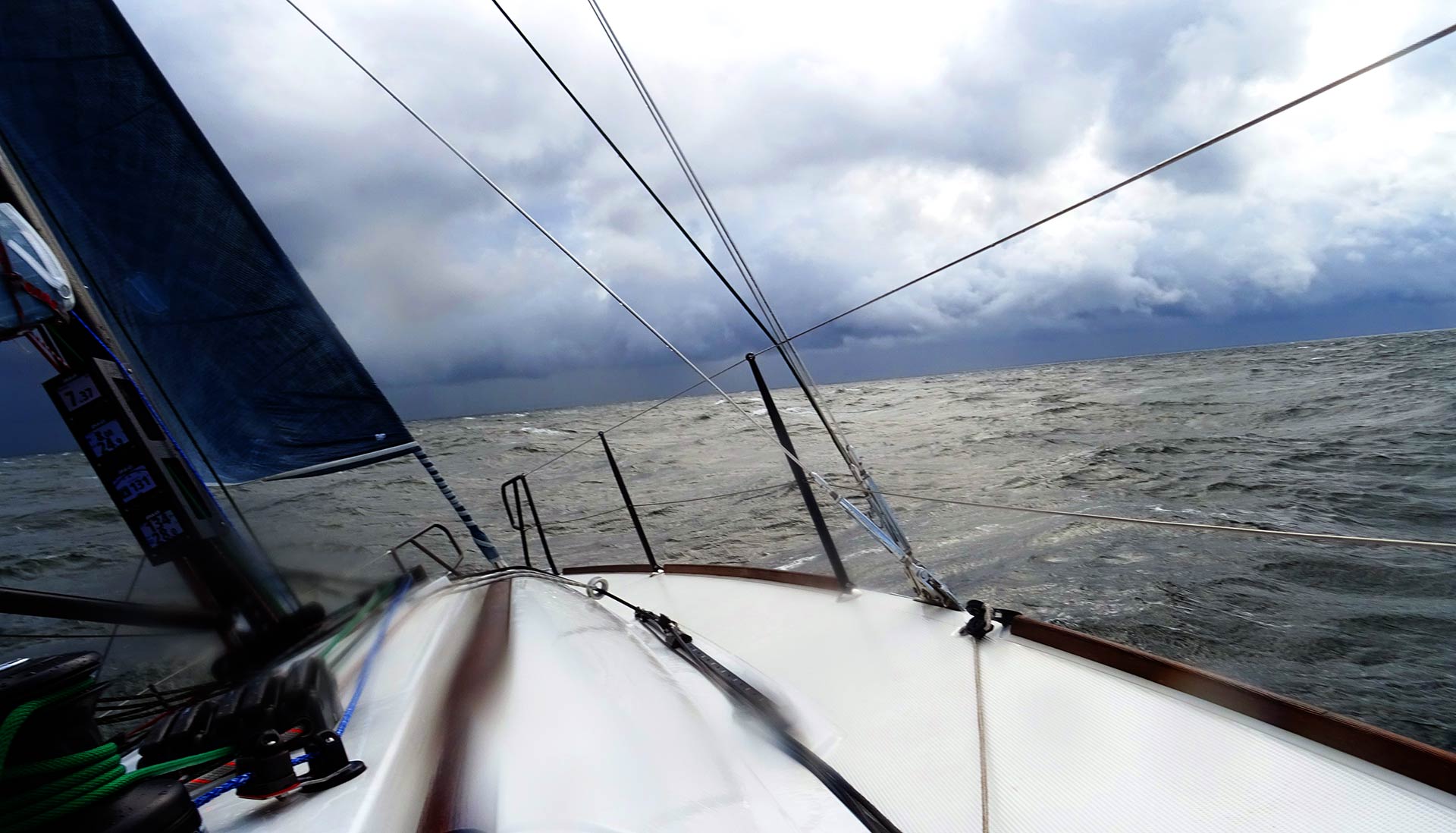
These forces of nature were simply overwhelming. 37 knots, that´s a low force 8 on the Beaufort-scale and not a real storm yet, but again, the hollering of the strong gusts in our rigging, the loud and ear-piercing roar of the wind was breathtaking. When a rain shower set in – always just for a few minutes – I couldn´t even see our own boat´s bow, let alone other ships or buoys. Raindrops were piercing my cheek like millions of cold needles. Most awe-inspiring those moments, when – just for a few seconds – the force of the stormy winds was able to rip apart the dense, dark cloud cover and shine through a small hole in the sky: Then the seas would light up and bloom, shine bright in a furious, boiling green, the horizon glooming in an enchanting rich blue tone. I instantly fell in love with this scene, as intimidating as it was, the more beautiful this natural violence occurred to me. Fear? No way! Fascination and respect. And right into this romantic daydream, it happened …
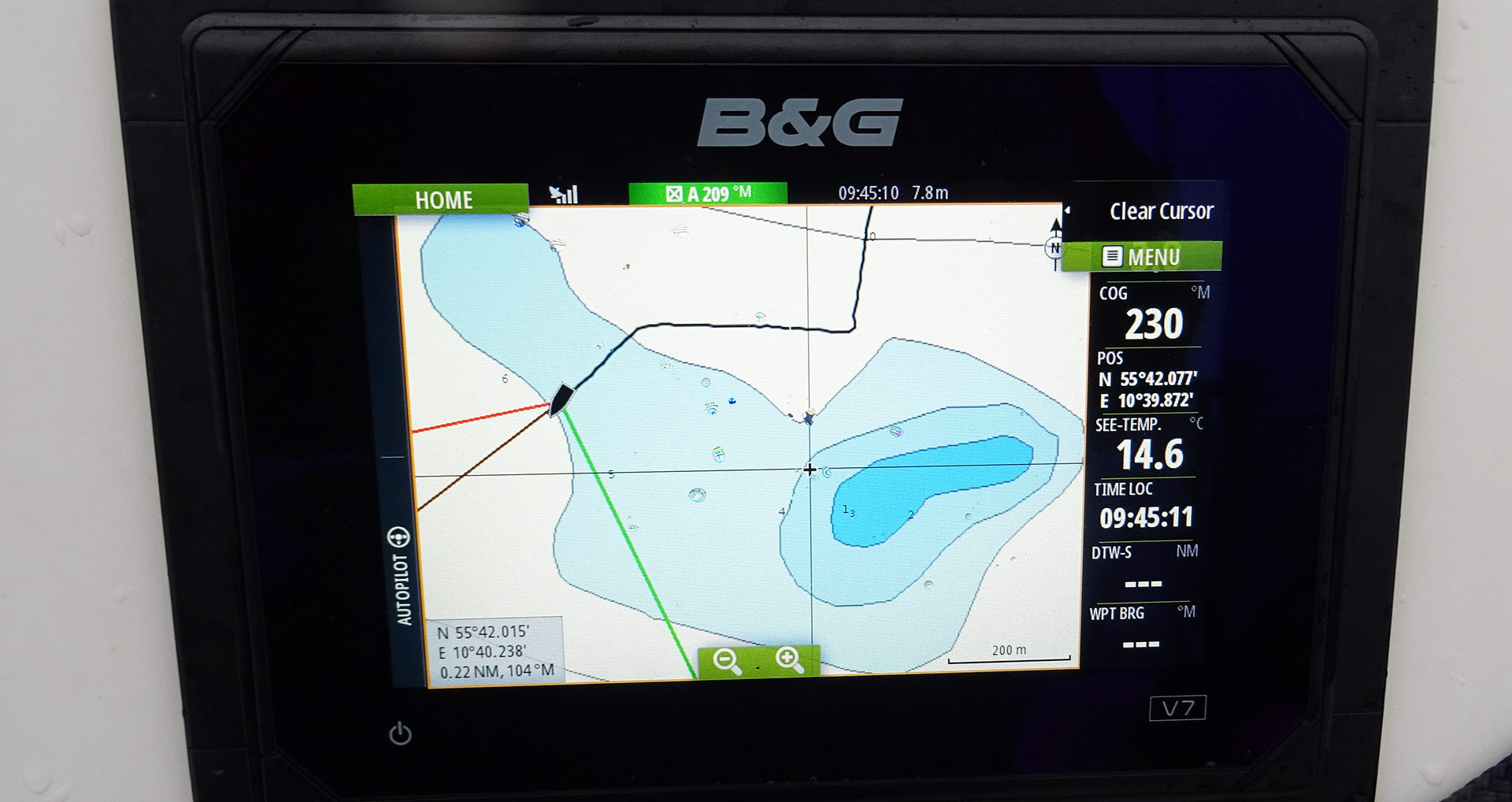
… a crippling shock suddenly bolted down my spine, blood and Adrenalin was injected into the system, alarming my brain, waking me up. Then I suddenly screamed: “Brace! Brace, hard to starboard!” and yanked at the tiller as much as I could, the boat laid over to port side and the bow dashed right into the incoming waves. Spray was coming over and a violent rocking set in. I even pushed down the gas handle of the engine to enable the boat to steam with more power right against the seas, my mate´s face full of question marks appeared in the entryway: “What´s happening?” “We nearly hit sea bottom. Missed it by 200 meters”, I yelled back. By looking at the plotter – due to the big zoom factor to find buoys – I didn´t got an overall picture of the seas we were crawling. So it happened, after some minutes when I returned to our old course and diligently checked our track, that by chance I steered the boat unknowingly right into a 1.8 meter shoal, not bigger than 20 to 20 metres, a small berg in the midst of otherwise deep water. I was shocked and embarrassed. Very, very bad seamanship!
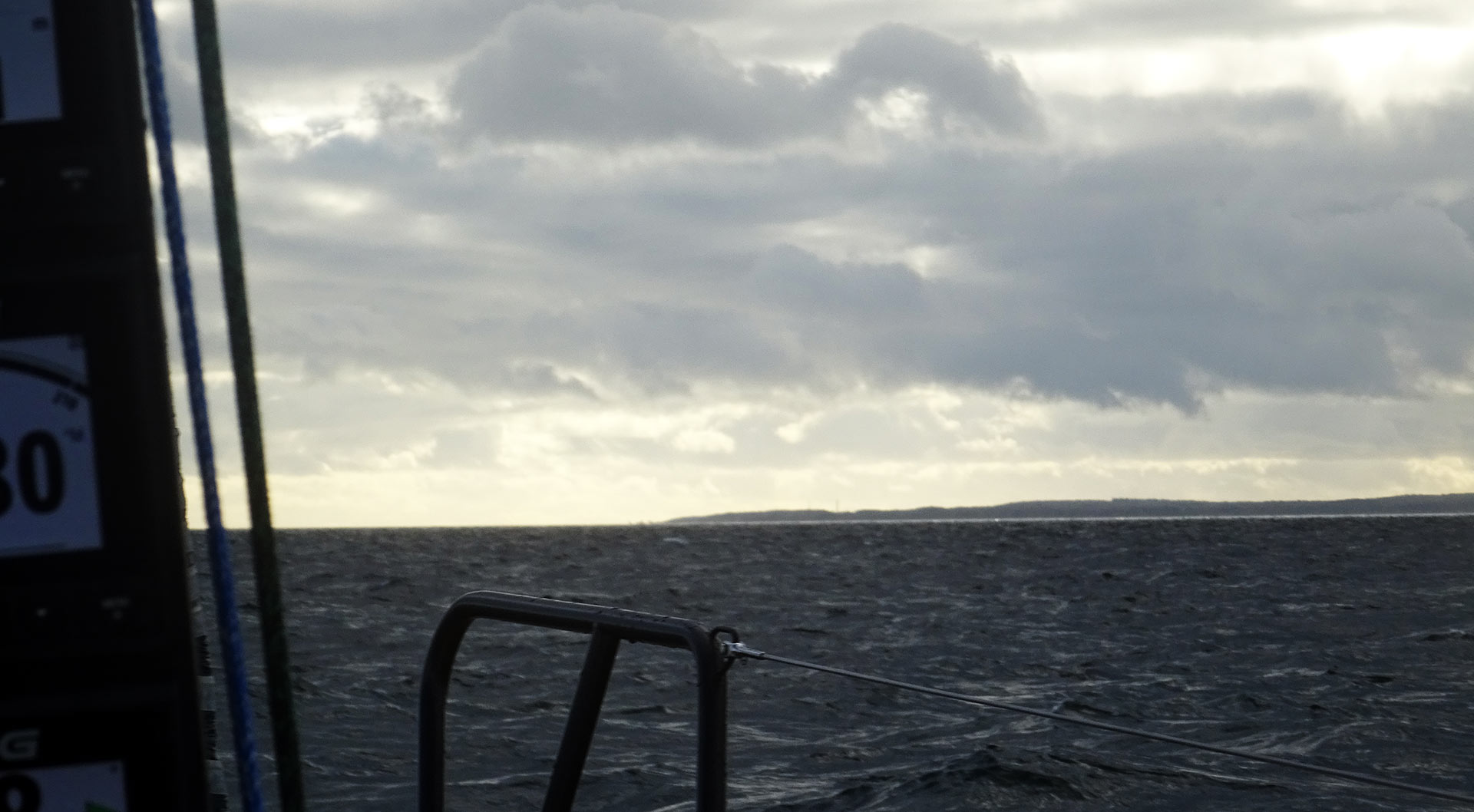
“Fyn in sight!”, I shouted with relief after some three hours of hard steering. Now it was just a matter of a short time until we would get into the lee of this island and hopefully the swell would die down. The idea was to be able to set sails again – fully reefed of course – and to at least for the last couple of miles turn the First into a real sailing boat again. But I was still puzzled by my navigational stunt, it really bothered me: “What a mess!”, I yelled in anger: “This boat doesn´t have a proper chart table, so I can´t do chart work. I would normally check our course on the charts for such hazards!” That´s a lesson, a tough lesson – no matter how hard, a skipper should always know where he is going and what´s in the way. “I can´t believe it! This yacht has a draft of 2.1 metres. The shoal was 1.80. Waves of up to 2.50. Just imagine hitting this damn underwater hill in these conditions!” I was so angry. At myself. My mate amended: “And we don´t have a working VHF!” “Take the helm, I´m on the toilet!” I said and disappeared down below to cramp myself in the rocking bow to get some body relief.
Foul Weather Sailing: Local Reality vs. Global Forecast
Just as I got myself peeled out of the multi-layered foul weather gear and finally got to sit down on the toilet, both arms jammed to either side holding myself sitting tight on the ceramics a number of very hard blows battered the bow and I felt my guts flying high and falling down a couple of metres. My mate yelling frantically down the companionway: “Whoooooaaaa, that´s a 39.4 knots gust!” I just tried not to piss myself as he complemented: “That´s a Beaufort 9!” Hurrying to finish my business and getting dressed again I got some more bruises whilst trying to get on the trousers and jacket without being thrown all around in the cabin and got back into the cockpit – feeling slightly seasick. Just these 5 minutes of being down below in this heavy swell have been enough to shake the system.
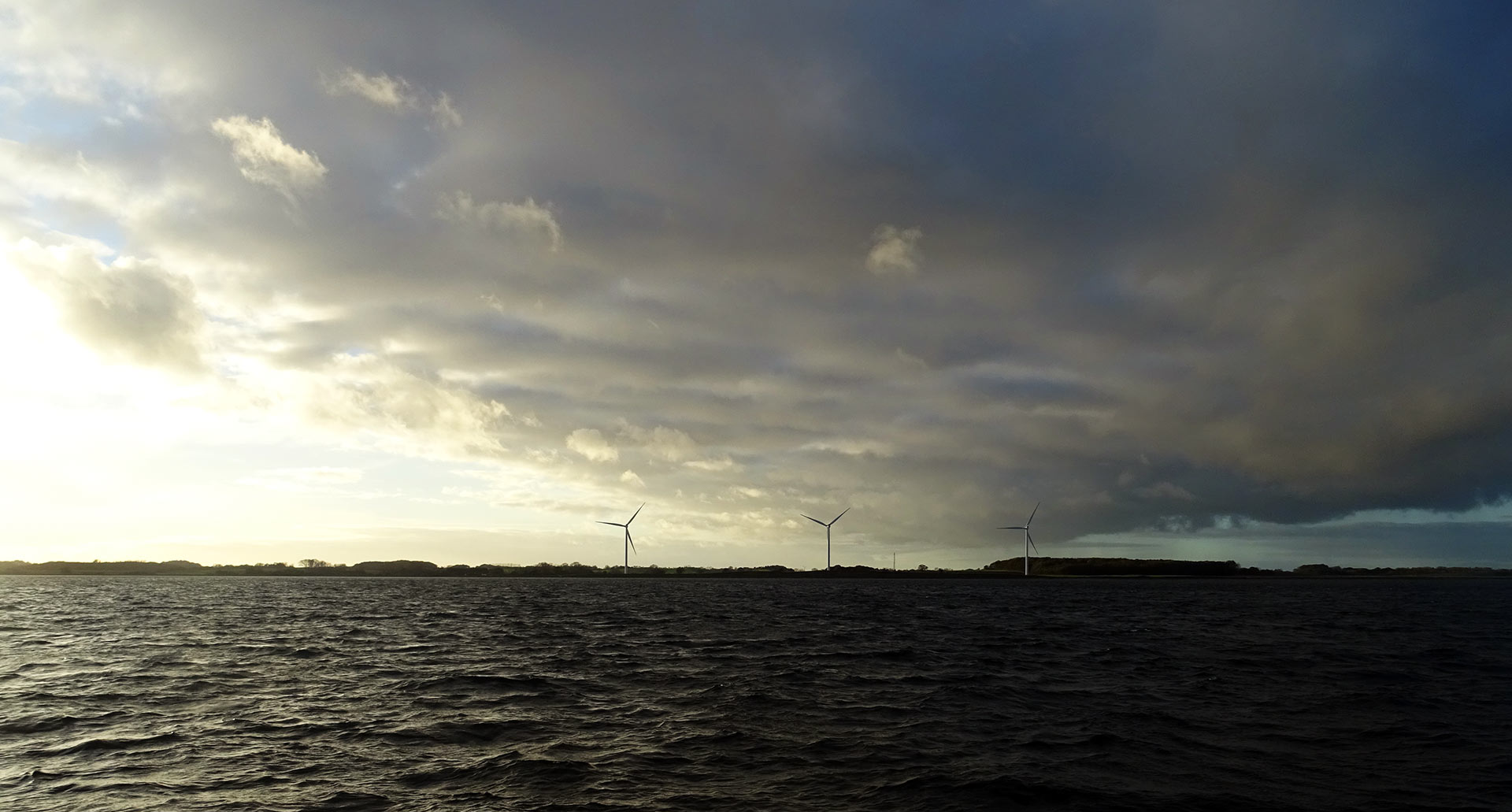
“Where´s this swell coming from?”, I screamed against the noise of the roaring winds: “I thought we´d be safe from those big waves in the lee from Fyn by now?” And reassuring myself I looked to the starboard side where in some 5 to 8 miles distance the Island of Fyn was clearly visibly. My mate pointed to starboard ahead: “See this small island? I think in its lee the waves are criss-crossing as the wind does creating this awful swell and those williwaw-style winds!” I find it amazing to really witness how geographical things – even the smallest – will change weather patterns and the appearance of the seas locally – sometimes diverting drastically from the general weather.
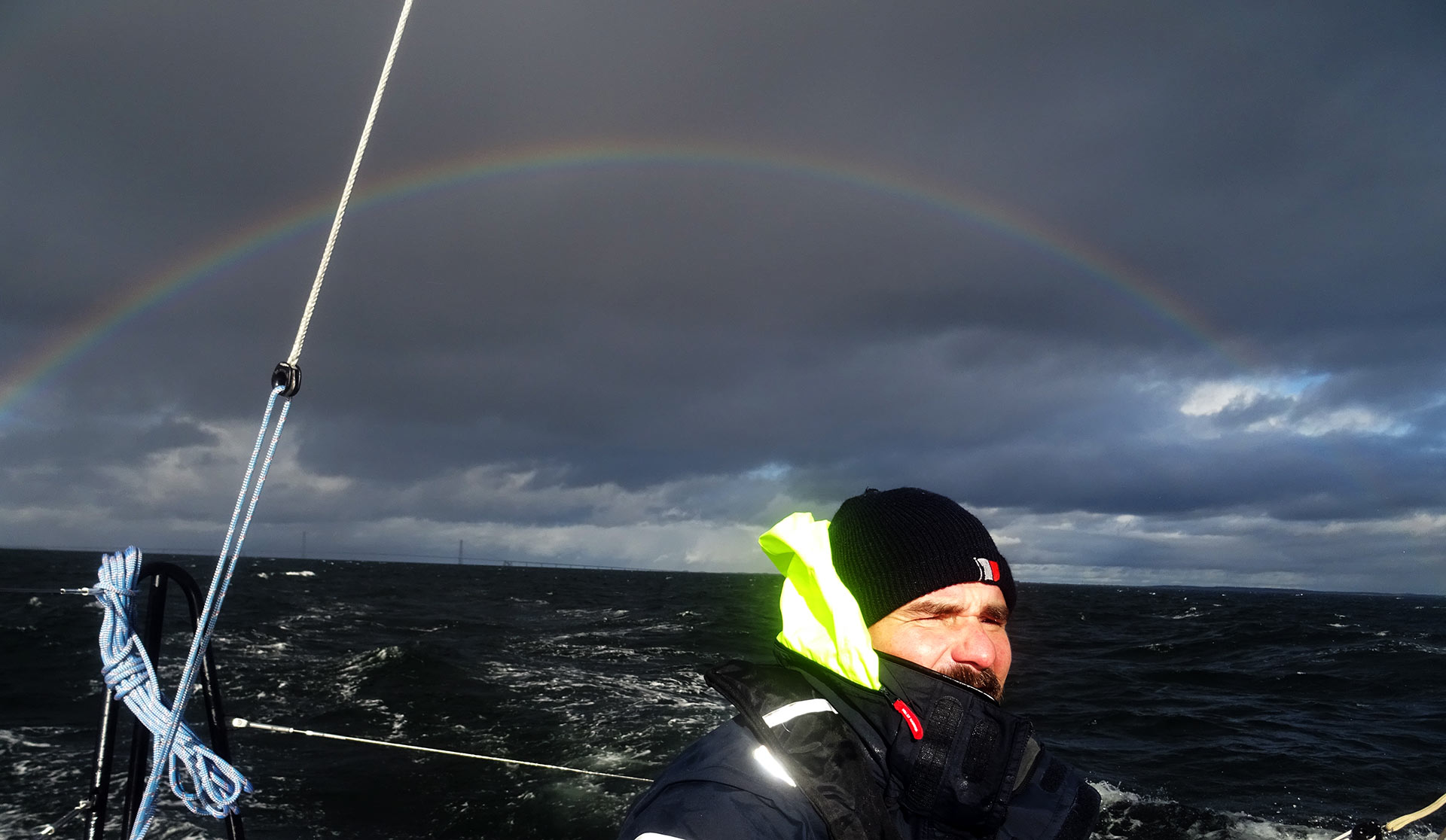
“The wind should have settled down by now far more!”, my mate concluded. Apparently the forecast wasn´t that accurate. We expected the wind to ease from 25 to 30 knots to around 20, 22 knots at around 2 p.m. but it just didn´t. The low profile of Fyn didn´t prevent the hard blowing gusts from hitting us hard as ever and up until now there was no chance of getting the sails up and switching off the engine. As we were passing the little Island of Romsö, the boat was shaking hard in the heavy seas, chaotically battering the boat. We occasionally got quite some heeling by vortexes of wind. Passing the island the seas calmed down to their usual pattern and it was far easier to steer the boat.
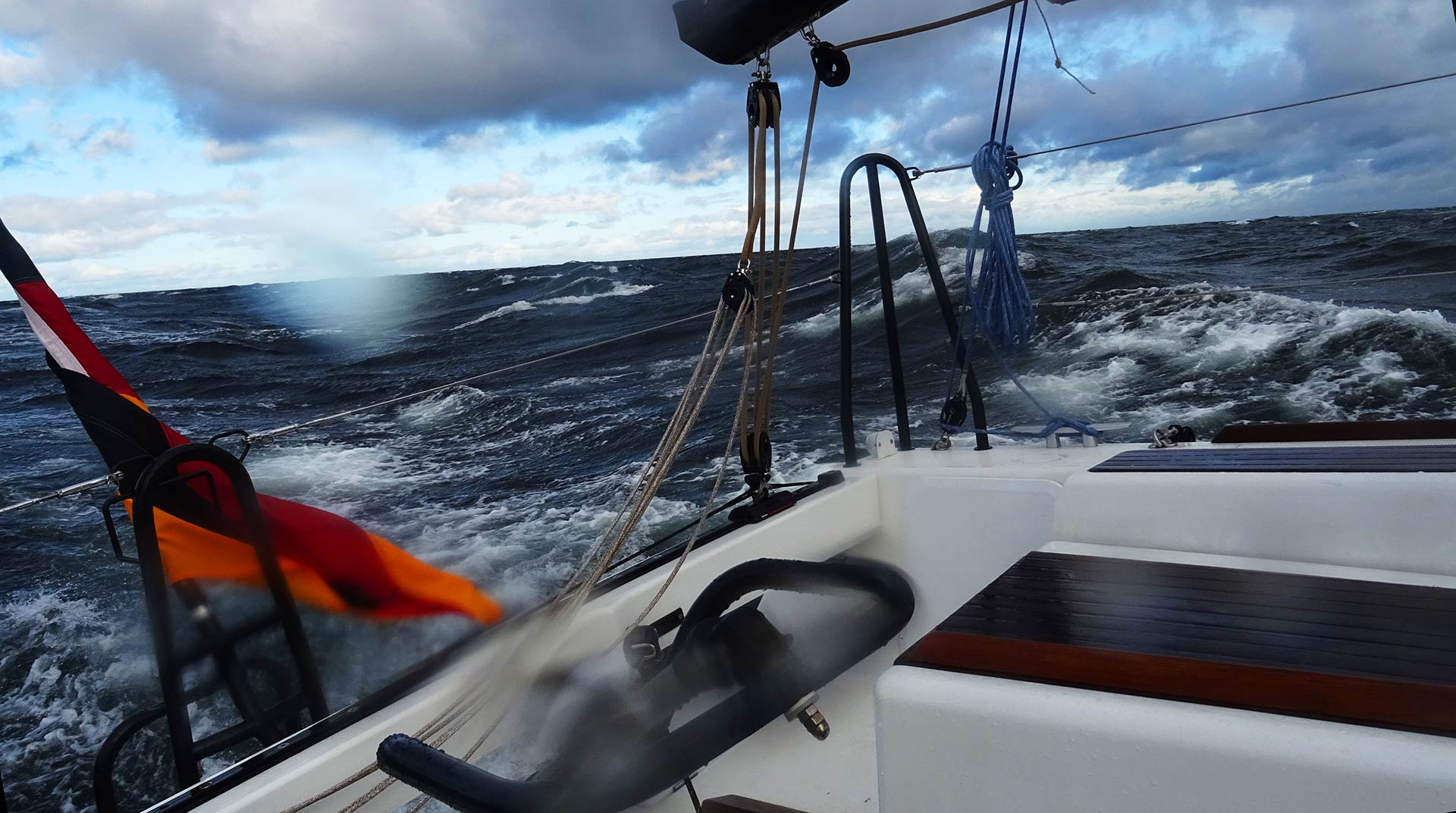
Nevertheless, the hoped-for protection against waves by the lee of Fyn didn´t really set in. I occurred to me that even a fetch as little as 4 miles was sufficient enough for this strong blowing wind to pile up waves of up to 2 metres. Sometimes, like every 8th or 9th wave, it seemed to me that two or three waves did overlap each other to create a kind of “little-freak wave”. I tried hard to anticipate the movement of the boat and laid rudder well before the power of the waves assaulted the hull and I managed to do so quite good – changing course toward the waves to get surfing down the wave tails. But just as I was smiling to myself in victory, the second and third “freaky” wave tackled the boat hard and jerked us off course so that I had to pull strongly at the tiller to get back to course again. Helming in such conditions is a tricky thing, but manageable.
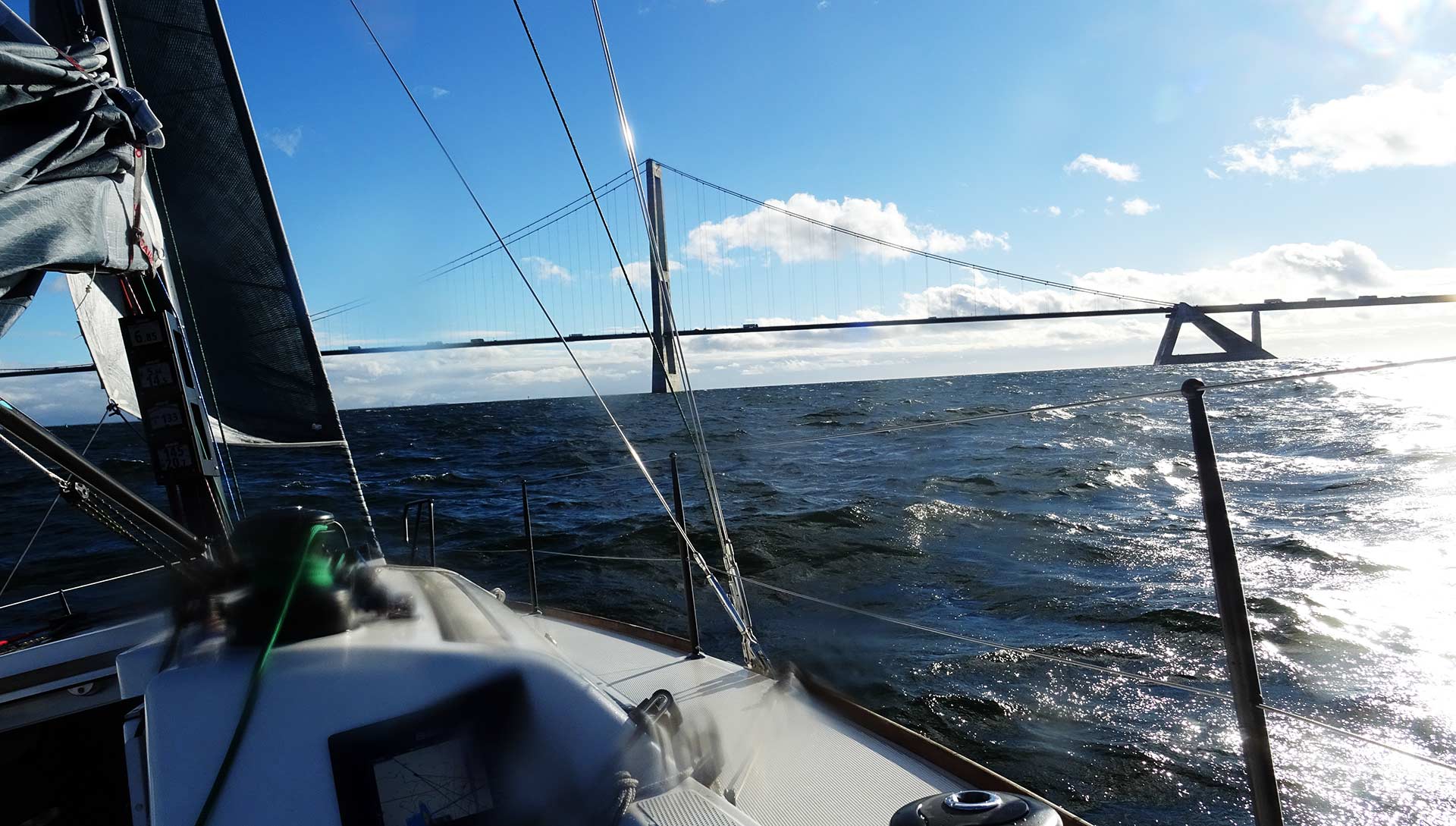
“You see”, my mate yelled up from his position downstairs at the entryway: “Nice and lush sailing on a 30 feet boat would be a Force 3 wind. On a 40 feet boat a Force 4 wind and on a 50 feet boat a Force 5 wind.” I knew what he was trying to tell me: Though a 1.50 metre wave pattern and winds of 25 to 30 knots may be just a nice bumpy wet ride on a 46 feet X-Yacht the same conditions might be experienced as full-out storm on a small 9 metre boat like ours. Though our yacht was CE rated Cat A as well, it wasn´t simply made to sail in such comparatively high seas and winds of up to 39 knots. On the other hand: “I am so much learning out here right now!”, I yelled back. And true it was! I more and more improved my steering abilities so that after some hours – although my arms were hurting from constant pulling and pushing of the tiller – I was able to prevent the boat´s heading from major diversions even in heavier seas. But I must admit, I was also hoping for the wind to ease as promised by the forecasts we checked earlier today.
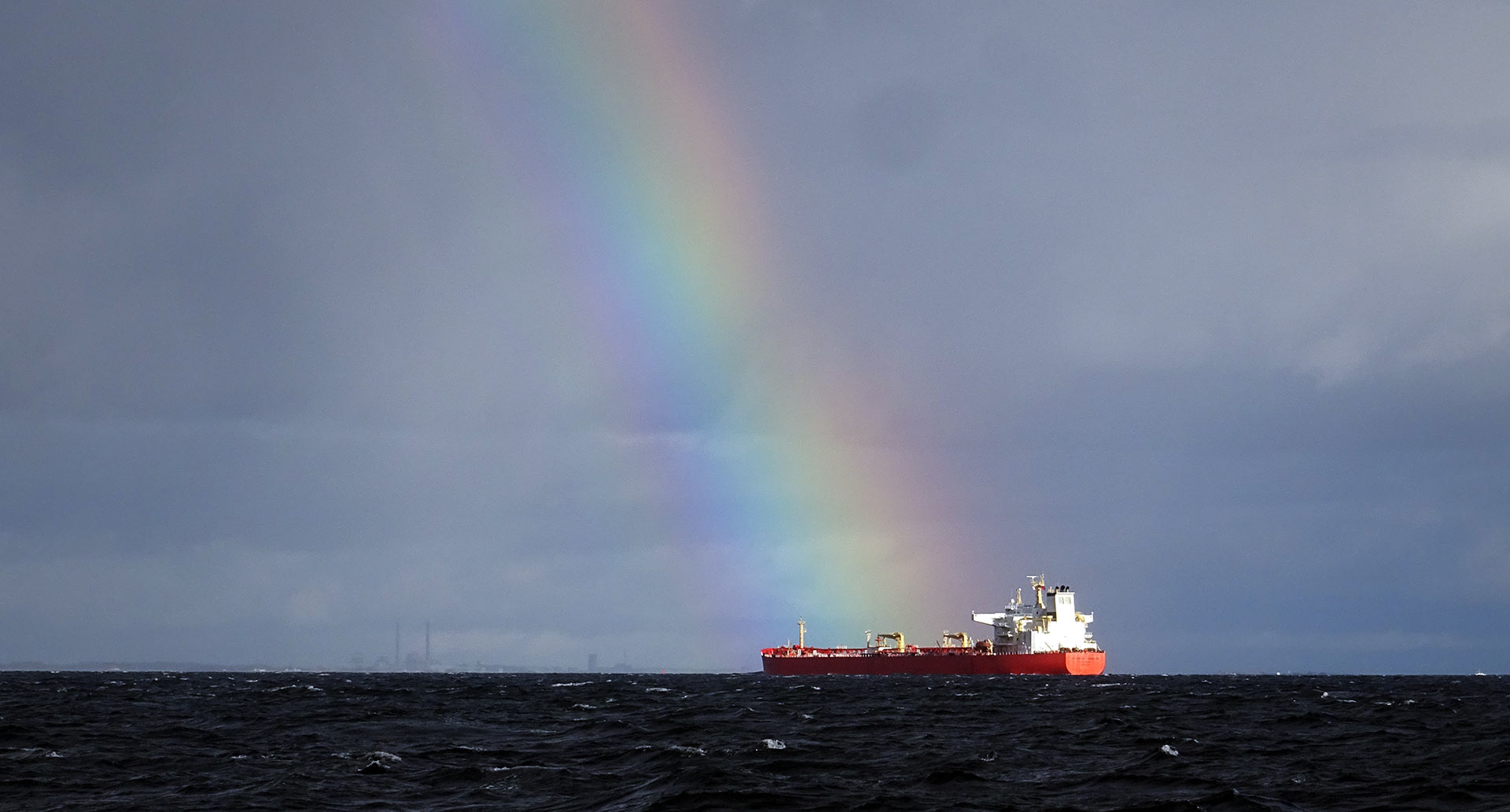
And then it happened. Right before passing under the Store Belt Bridge – which is one of the biggest manmade structures you can see here around – the sky spontaneously ripped apart and blue patterns of a clear sky fought their way over the horizon. The wind didn´t ease, but at least the sun came out more frequently and this change of light alone was enough to raise the mood instantly. Even Poseidon, Mighty God of the Seas, seemed to offer reparations and threw a huge rainbow across the horizon from where we came, just as he might wanted to greet us and make us proud of what we went through the last hours and where we came from. “Last hours …”, I though and got aware from the frequent cramping pain in my stomach: We casted off without any form of solid breakfast and hadn´t eat a thing since 7 or eight hours.
To reef or not to reef?
Just as we were one or two miles pass the Store Belt Bridge, I again was not very satisfied with myself as skipper of this boat in terms of good seamanship. From my last rounding of Fyn I knew that every boat, even yachts, are meant to give a VHF call to the bridge commanders to register the passing. Since our VHF apparently hadn´t been installed properly, we couldn´t do that. That´s just not good – and having a working VHF is a must have, especially in these conditions! Nevertheless, we got in sight the northern tip of the Island of Langeland very soon and estimated the ETA in the – even nearer lee of this island – to one hour. “Then I promise we can set up our sails!”, my mate jollied me and smiled.
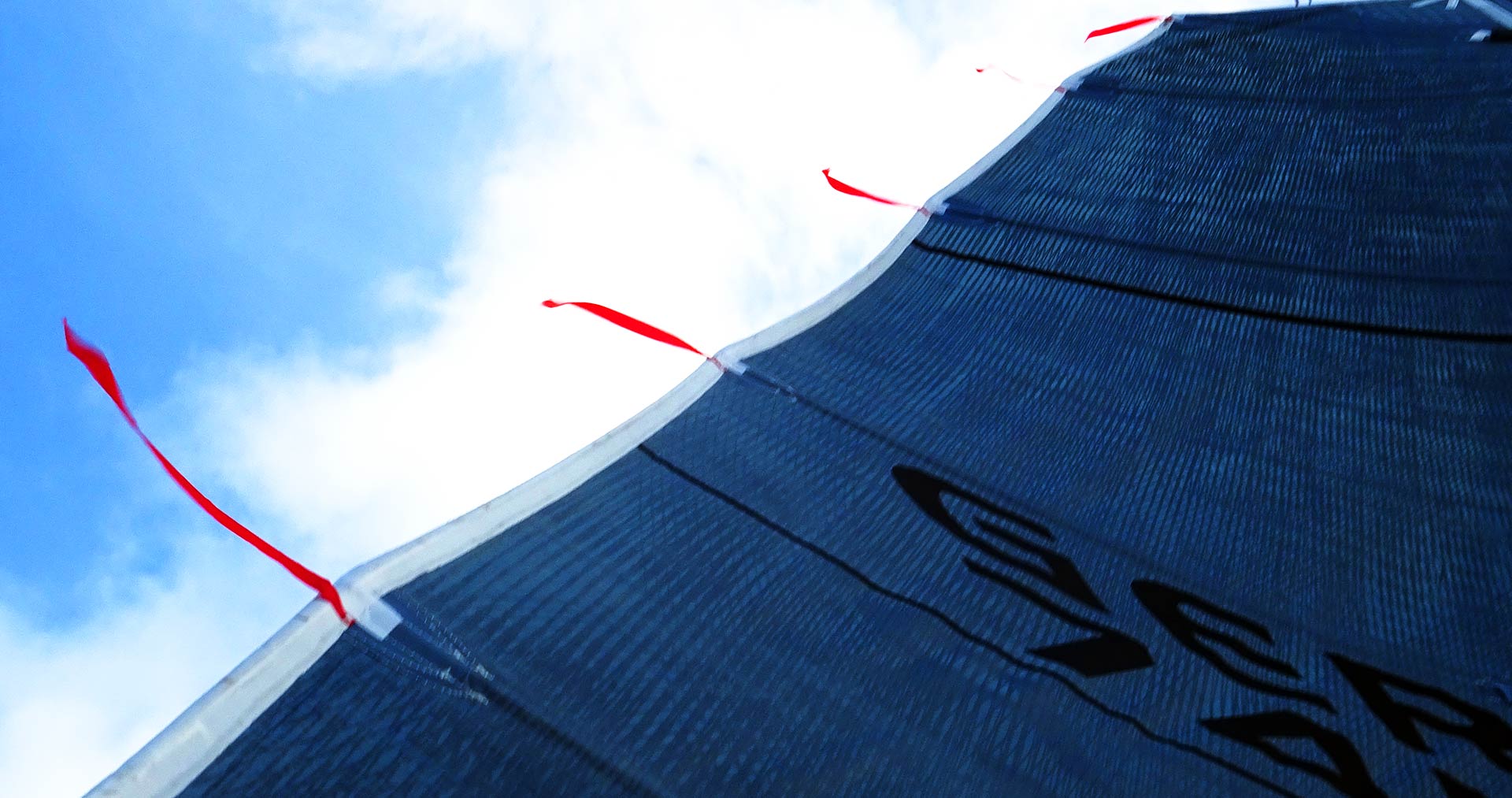
And so we did. And to our great relief, finally, the wind also eased a bit down to 20, 24 knots TWS. We learned from yesterday´s fault in getting the second reef into the main sail by having attached the reefing line earlier this morning to the reefing clew. It didn´t looked particularly nice but at least we could hoist the main in the second reef now. And what a pleasure it was! As the red tell tales were flying again and I even could enroll a tiny bit more or job area the boat heeled over quite nicely and I switched off the engine.
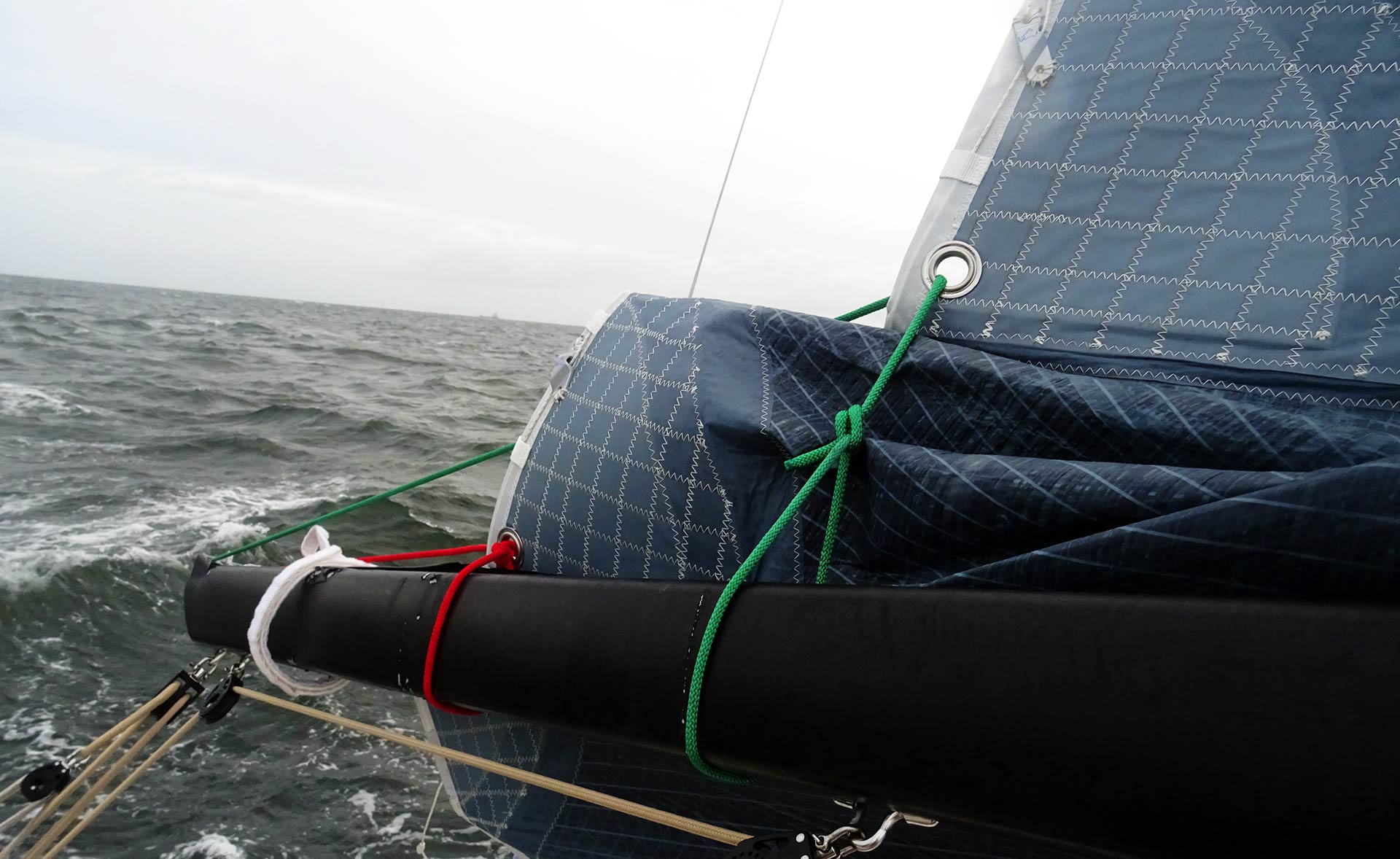
The boat didn´t even slow down a split of a knot and jolted to 7 knots with ease. Another harder gust of 30 knots cooled down a bit our enthusiasm and I reefed the jib again, but nevertheless: “This is a sailing yacht again. Finally!”, my mate sighed in relief. “Amen!”, I whispered. He instantly jumped back to the helm, asked to take over which I granted with joy due to my aching arms. Placing himself on the high side of the cockpit not utilizing the automatic steering he was full of pleasure, smiling and whistling. I was stunned of how fast the mood aboard changes, like in a second, when the feeling of imminent danger to either boat or crew eases.
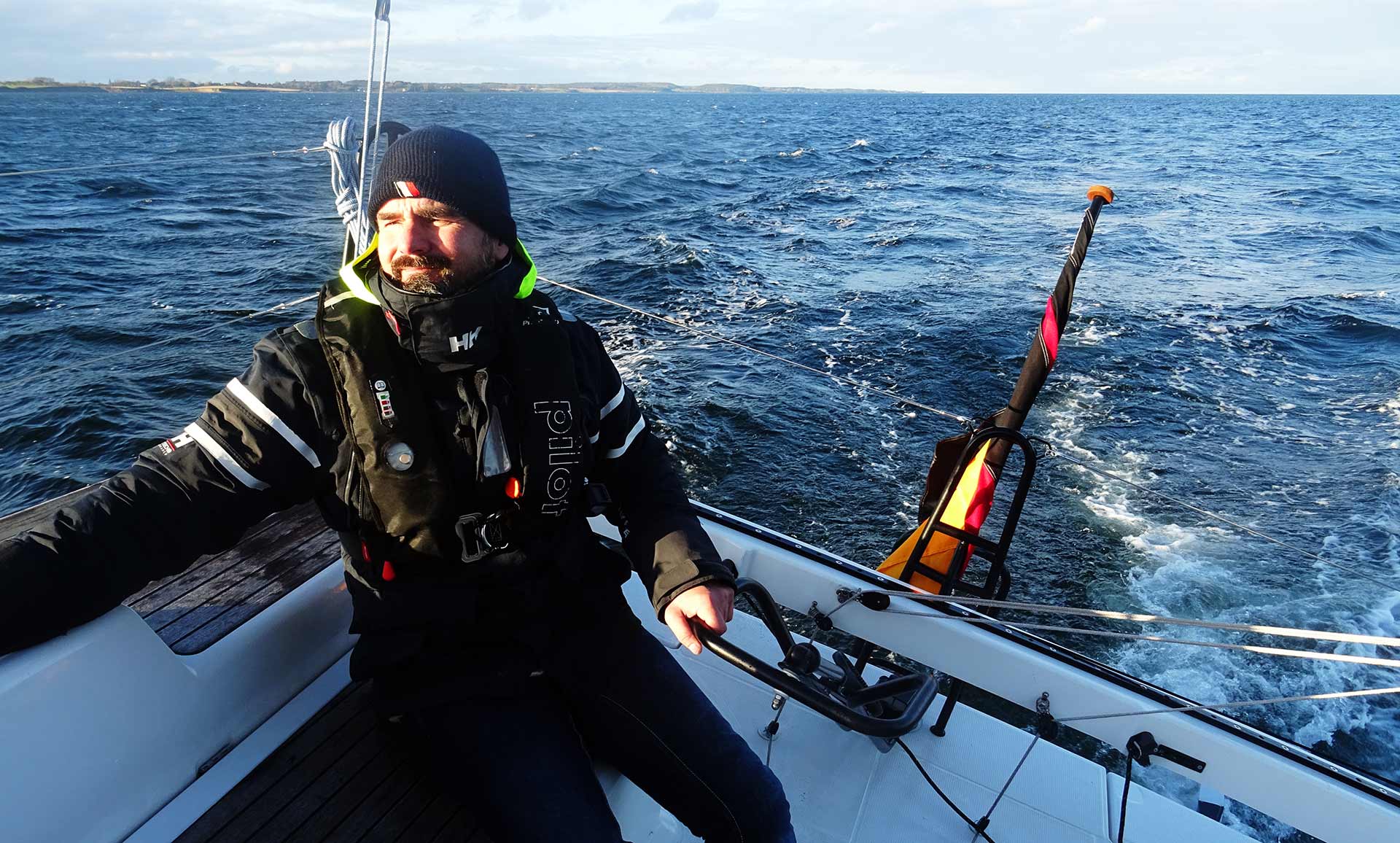
Instantly we were back to our singing modus-operandi, howled Shanties into the still roaring seas and threw citations of our beloved “Das Boot”-movie at each other. Joy was back on board and it was true pleasure. I even was able to grab a handful of candy bars and some fresh carrots out of the rolling provision bunkers to at least get something into our stomachs which were still aching.
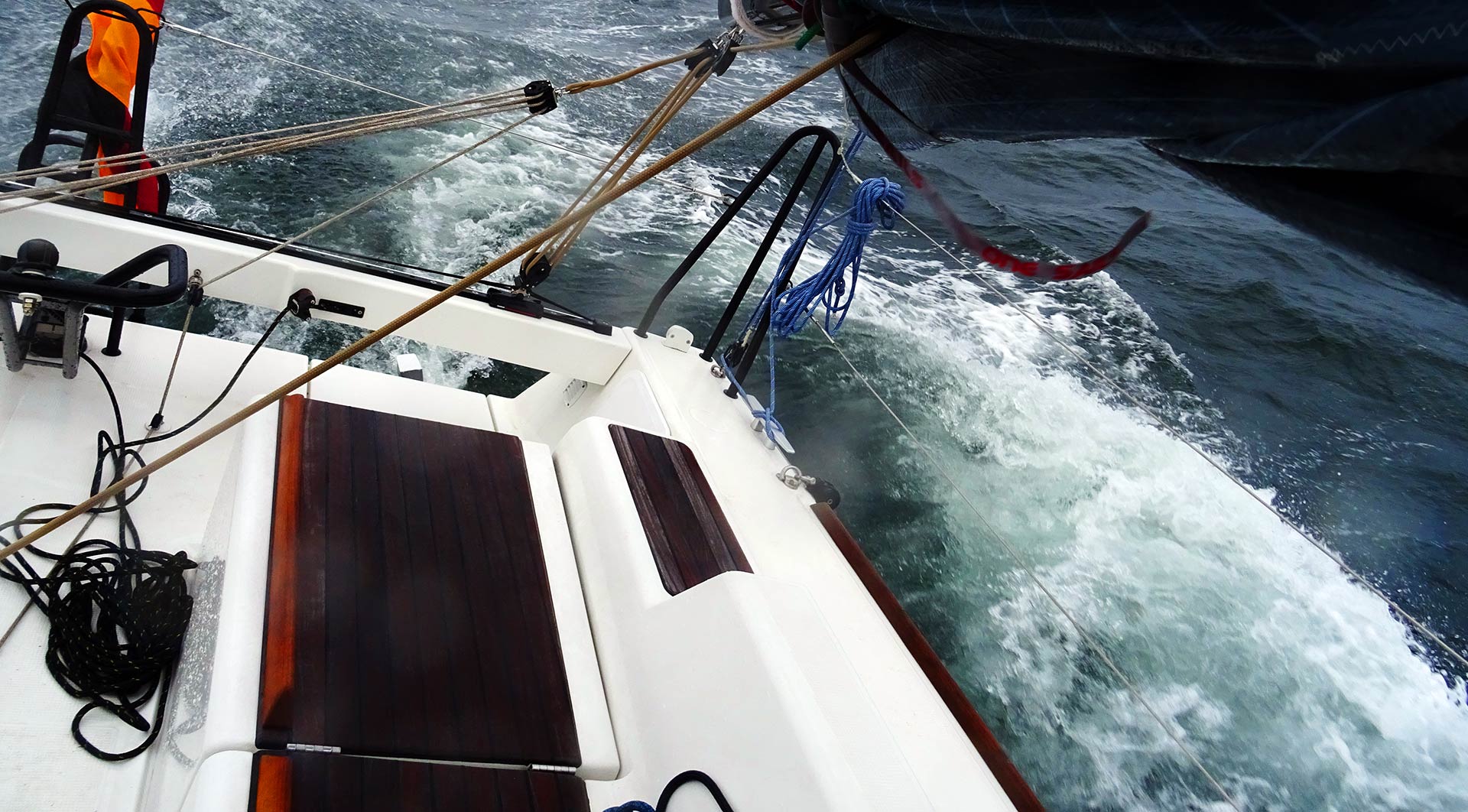
It still wasn´t easy sailing though. Waves did get lower indeed but could still push the boat off course. Now that we didn´t had the constant pushing of the ship´s screw in the water, gusty winds would do their part and when the bow was burying itself into one unfortunate wave the boat instantly slowed down 2 or 3 knots, making it even more vulnerable to battering waves. Nevertheless, we had the sun of the late afternoon shining brightly, even drying our soaked wet clothes a bit and turning the once grey Baltic water into a deep blue colour, plunging the landscape of near Langeland in the most beautiful gold-saturated greenish colours one can imagine. What a rich people we were!
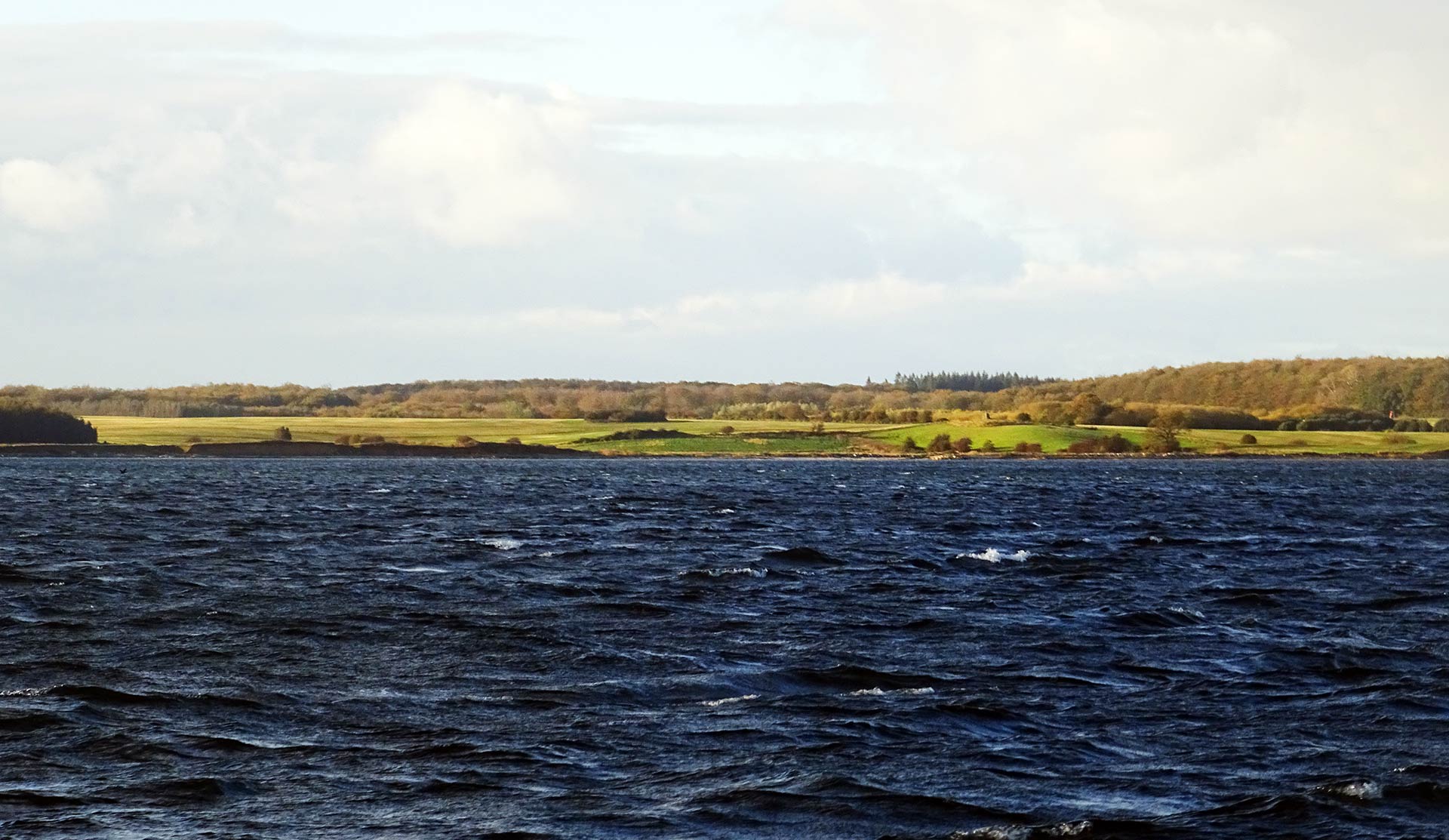
It was a matter of one and a half hour of pure joyful sailing into the dawn of the sun to our destination for today: The small marina of Spodsbjerg. It´s situated down at approximately right in the middle of Langeland and is the only harbour for yachts to the western side of the Store Belt. We could spot the scene from very far and as it is customary to me, I was checking the highest zoom on our plotter to get a feeling for the marina. I instantly spotted a jetty where we could land alongside – if free – and have a nice mooring place for the coming night. My mate was in his own world, clearly enjoying these last hours of sailing after so many miles of rocking up and down in the heavy swell under engine.
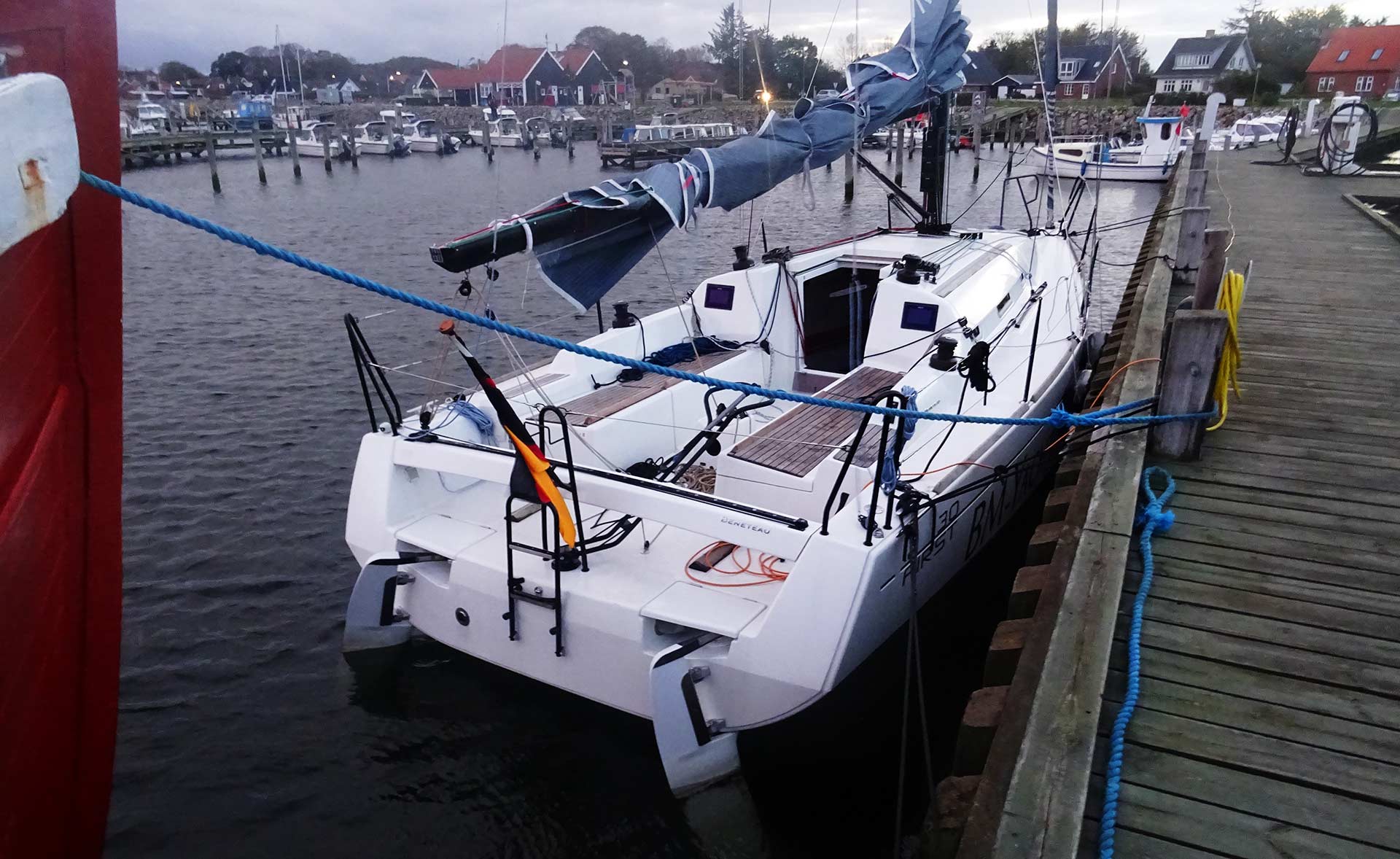
As we finally landed our Beneteau in Spodsbjerg – for the first time ever during daylight – we were shaking our hands and congratulated for this leg. We did everything in the right manner, made the right decision in leaving early: “Now, 20 miles to the North, there´s hell breaking loose, believe me!”, my mate said staring at his smartphone and checking live weather information. “Everything just turned out as planned!”, he drew a conclusion of today´s led and was clearly satisfied with his proposals. I, by myself, was satisfied as well, but because of a different thing: I, for the first time in my life, was out there for hours at the helm, withstanding the cold biting rain, the hollering of the winds and the spray of the breaking waves and steered the boat through this foul weather. Despite the near-grounding … of course. Time to prepare a hot meal. Get a beer. And some rest …
Being faster than the Storm
Gently had the tiny wobbles underneath the stern been constantly ticking at the boat´s hull and I was very lucky to instantly fall asleep. I needed this resting time because ever single hour of sleep was relevant: We set our timers to wake us up even one more hour earlier than on the previous day and so it happened that the nerving ringing of my mate´s smartphone ripped apart the cosy blanket of my sweet dreams at exactly 6 o´clock in the morning. It was still pitch black dark outside and when I got myself peeled out of the sleeping back I nearly fell to my knees: What a damn musclesoreness had been paralyzing my legs, especially the thighs and the abs. “Oh my god that hurts!”, I moaned and prepared a boiler of hot water for the coffee.
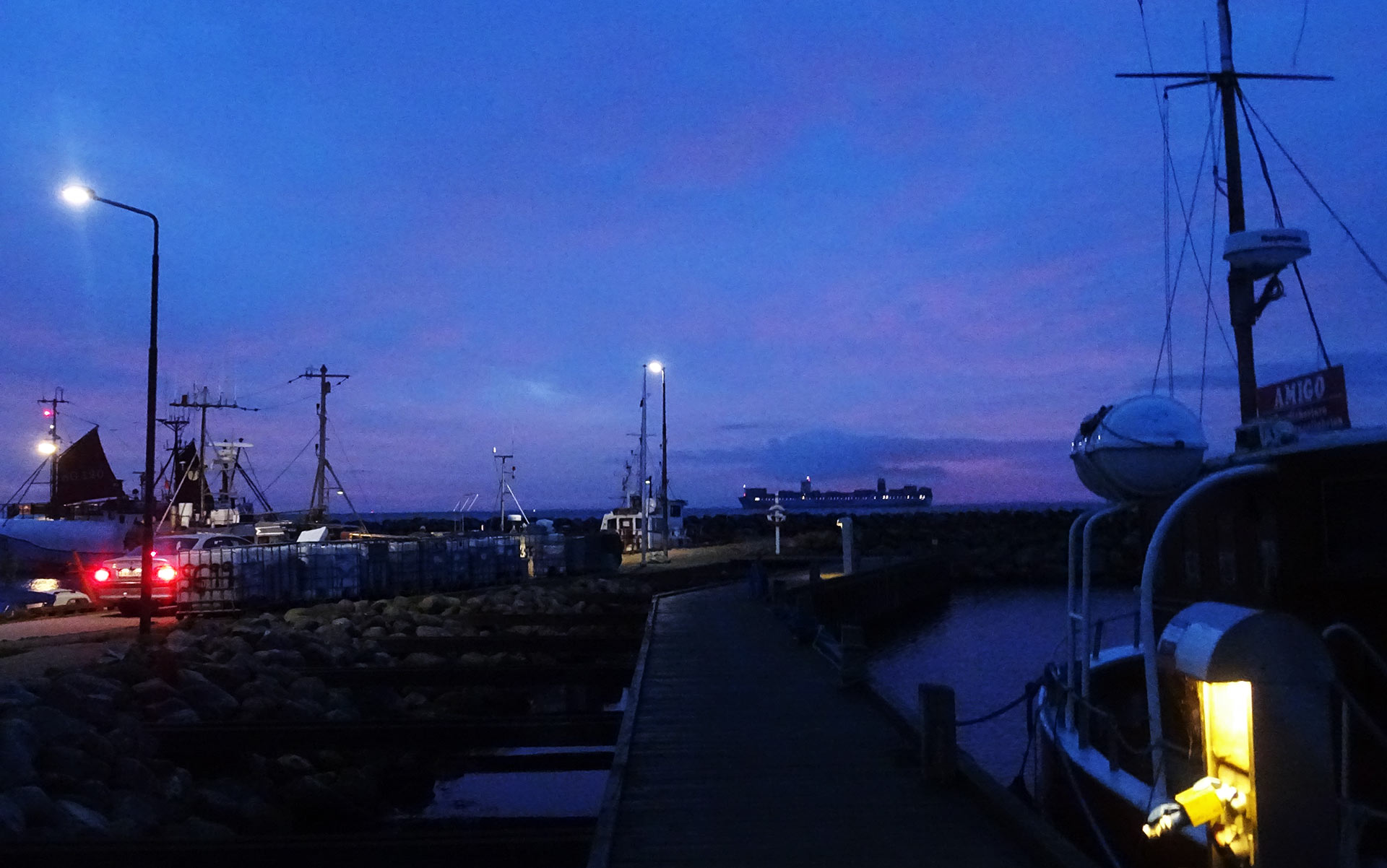
Then I remembered that at approximately 3 a.m. we both woke up from the noise of a loud running Diesel engine, the boat was lit up completely: A pilot´s boat came alongside and moored just one ship length away to bunker Diesel. After some 20 minutes the noise was gone and we fell asleep again. My mate´s hair looked awful, streaks were poking out in all directions as if they were magnetically charged. He stared – as usual – at his smartphone to check the latest weather forecasts. Then sighed: “It was good to get up early. Today we have a small window of opportunity.”

Winds have shifted to South during the night, which was unfortunate because we had to go down south for at least 40 miles today, but are expected to change to a strong Westerly at around 10 a.m. which would be perfect: Steaming down south by help of engine power we planned to reach the southern tip of Langeland and open sea room. Then winds would shift to West thus enabling us to hoist our sails and go down to a German marina, possibly Kiel or Laboe as the destination for today. “We have to be very fast today!”, my mate said in a worried tone: “Winds will be very, very strong in the afternoon and break 30 knots after 4 or 5 p.m.. We don´t want to be out there then – considering the open sea and the fetch, waves will be crazy!”
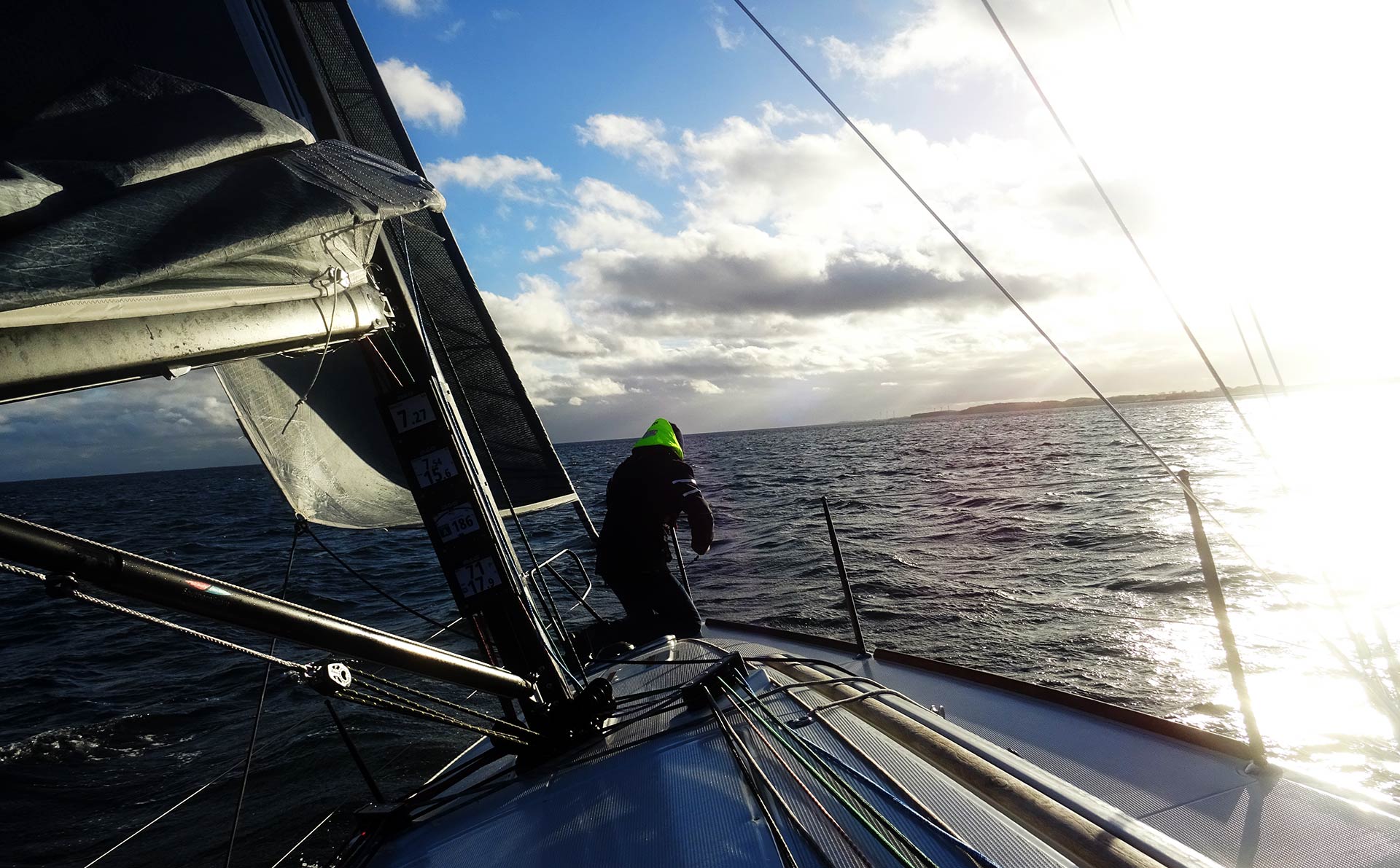
Let´s don´t waste any time again with breakfast, I though, brushed my teeth and grabbed the canister of spare Diesel fuel, filling up some 10 litres again. The engine of our Beneteau is consuming some 1 to 1.5 litres per hour, which is a great thing, but the bunker was half empty when we arrived. “We don´t want to refuel when being out at sea”, I said. Wind shifted earlier than expected to West and we could soon get up the sails and kill the engine. When the sun was up it turned out to be a perfect sailing day: The boat was speeding like hell because there was a nearly 3 knots current streaming down South adding to our 7 knots through the water. Everything seemed perfect. But then the Wind more and more shifted back to South and we had to bear away, giving up height because at some point we were sailing 205 degrees, instead of 170. “This will bring us too far east, probably to Fehmarn – but not where we want to go! Dammit!” Will it change back? Every hour sailed had to be an hour of making good leeway. And one hour more into the harder winds later the day.
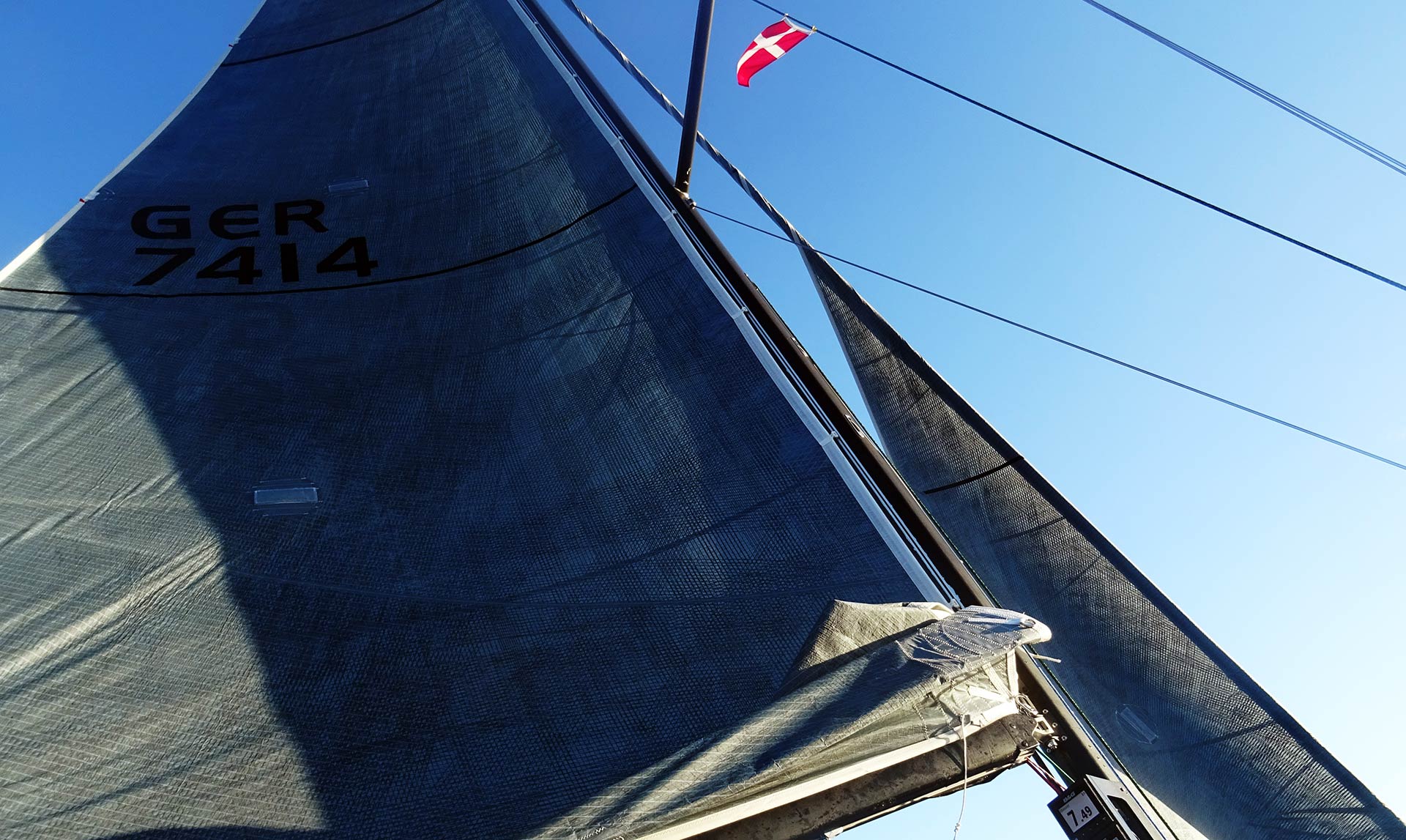
Winds already freshened up quite nicely and we took in the second reef in the main sail as a precaution. Nevertheless, the jib was unfurled completely and the yacht was making very nice speedy progress. But in the wrong direction! When will the winds change to West? I played around with the plotter and checked the German coast for possible other destinations. “Providing the fact that the wind really changes to West, why not skip Kiel, Laboe and even Strande and sail to the Schlei?”, I proposed to my sailing mate. And he reacted like I was hoping: By smiling.
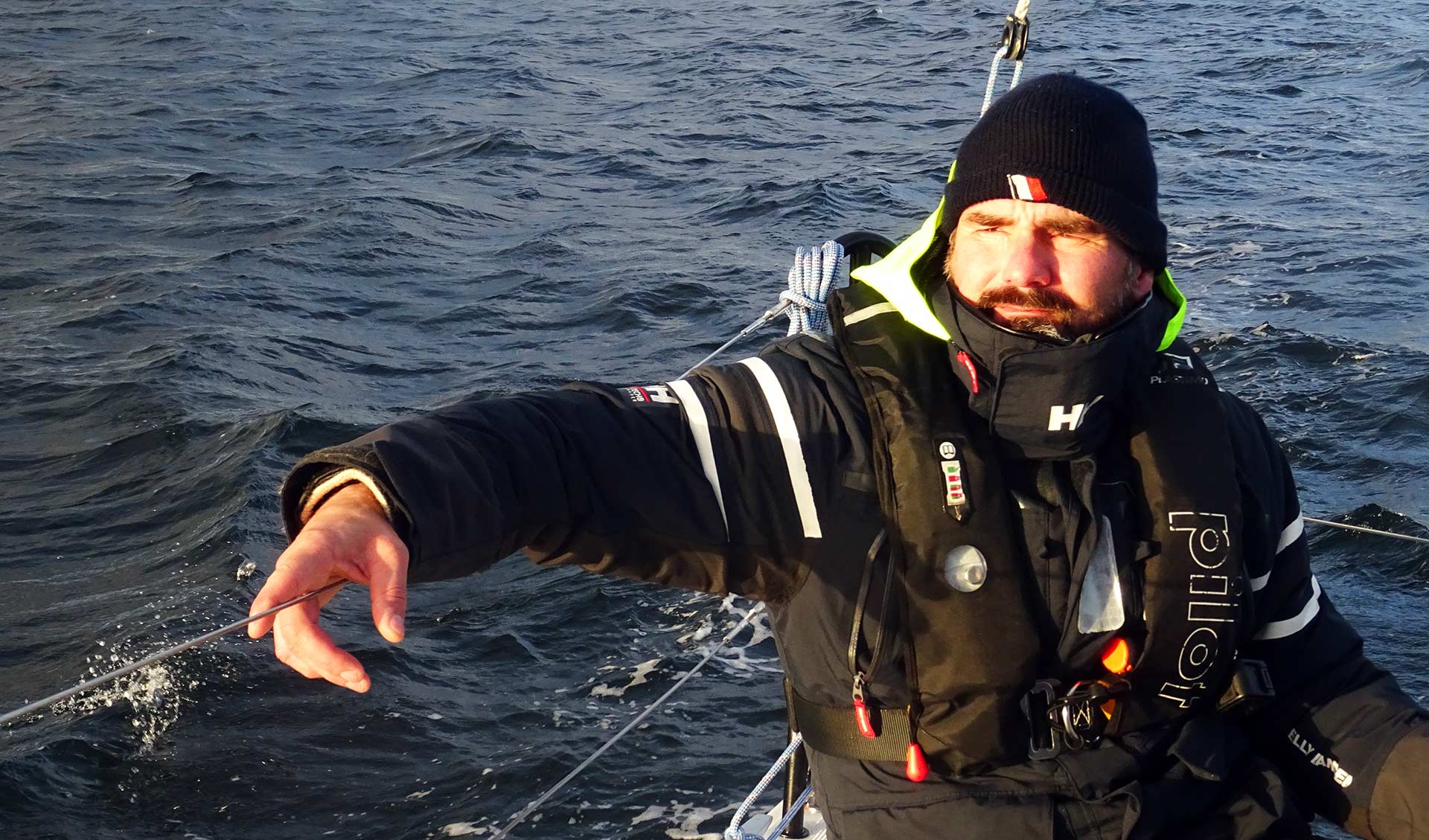
The Schlei is Germany´s one and only real Fjord and one of the most beautiful landscapes of this country. It is lined by gently swinging hills, green forests and jolly villages. Bristling with small marinas and loads of sailing boats. It´s a centre for people who seek a calm and traditional Northern German landscap happy to not having been fully commercialized. Yet. But he wasn´t smiling because of the prospect of sailing into this wonder of nature alone: It was my sailing mate and myself who, some 2 years ago, sailed out of this very Fjord my own boat, the SY OLIVIA, which was bought here at the Schlei. “Going to Kappeln would be a great occasion if winds permit and would bring us even nearer to Flensburg.”, I said – thinking of tomorrow, the last day of tolerable weather before the real storm would hit Germany.
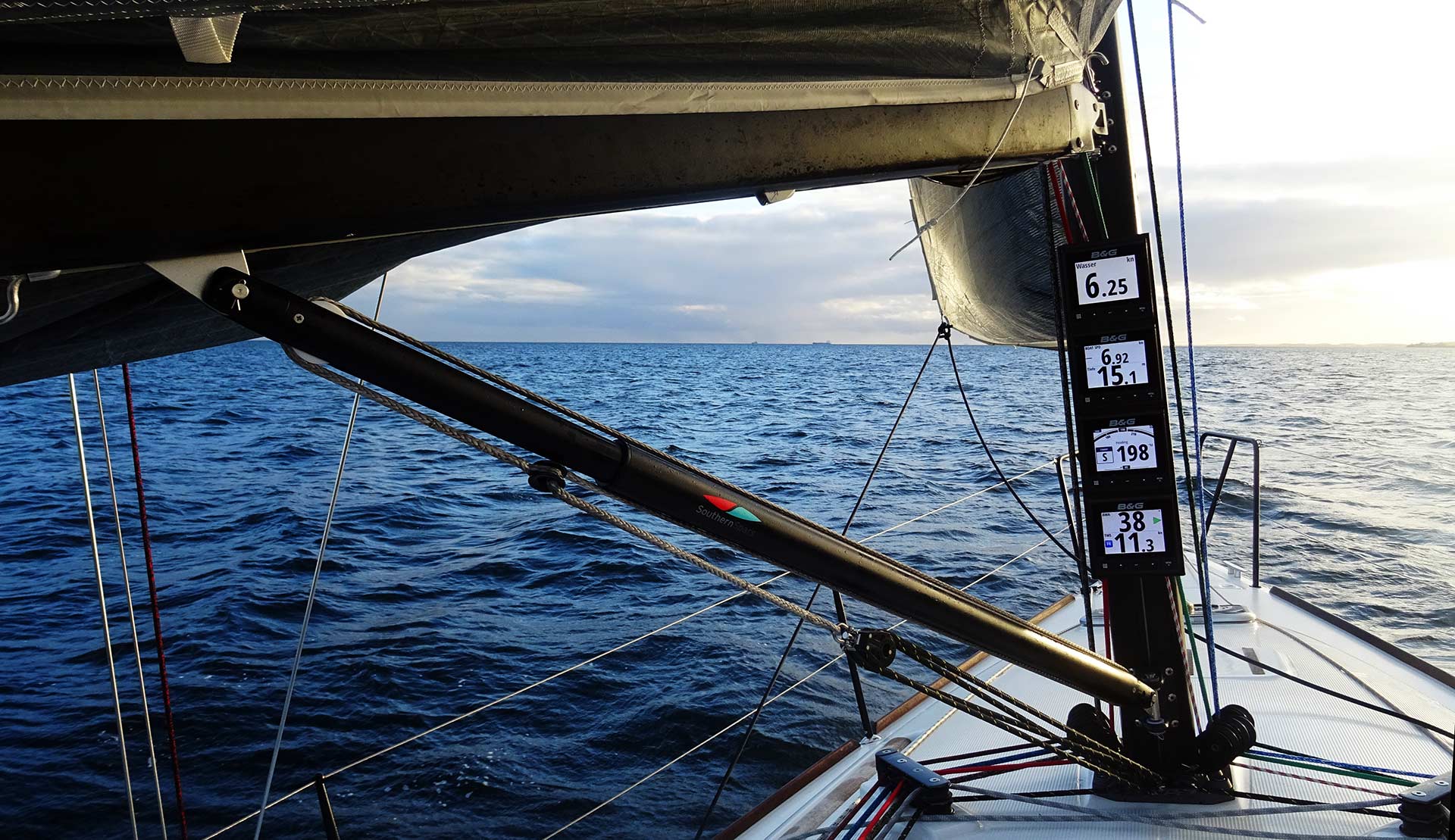
“I think the wind is shifting”, said my mate and watched the compass carefully: “I am able to steer 180 degrees now and every 15 minutes I can luff another 5 degrees or so. It happens!” That was the message I was hoping for. And so it went on until we could tack and steer 280 degrees which would bring us directly below the Island of Aerö and nearer to our destination, the Schlei-Fjord. Now that things again played out as hoped, the mood of my mate improved as well and he began to chatter around again. The sun was up and in full swing – it was noon – and the boat was making good progress.
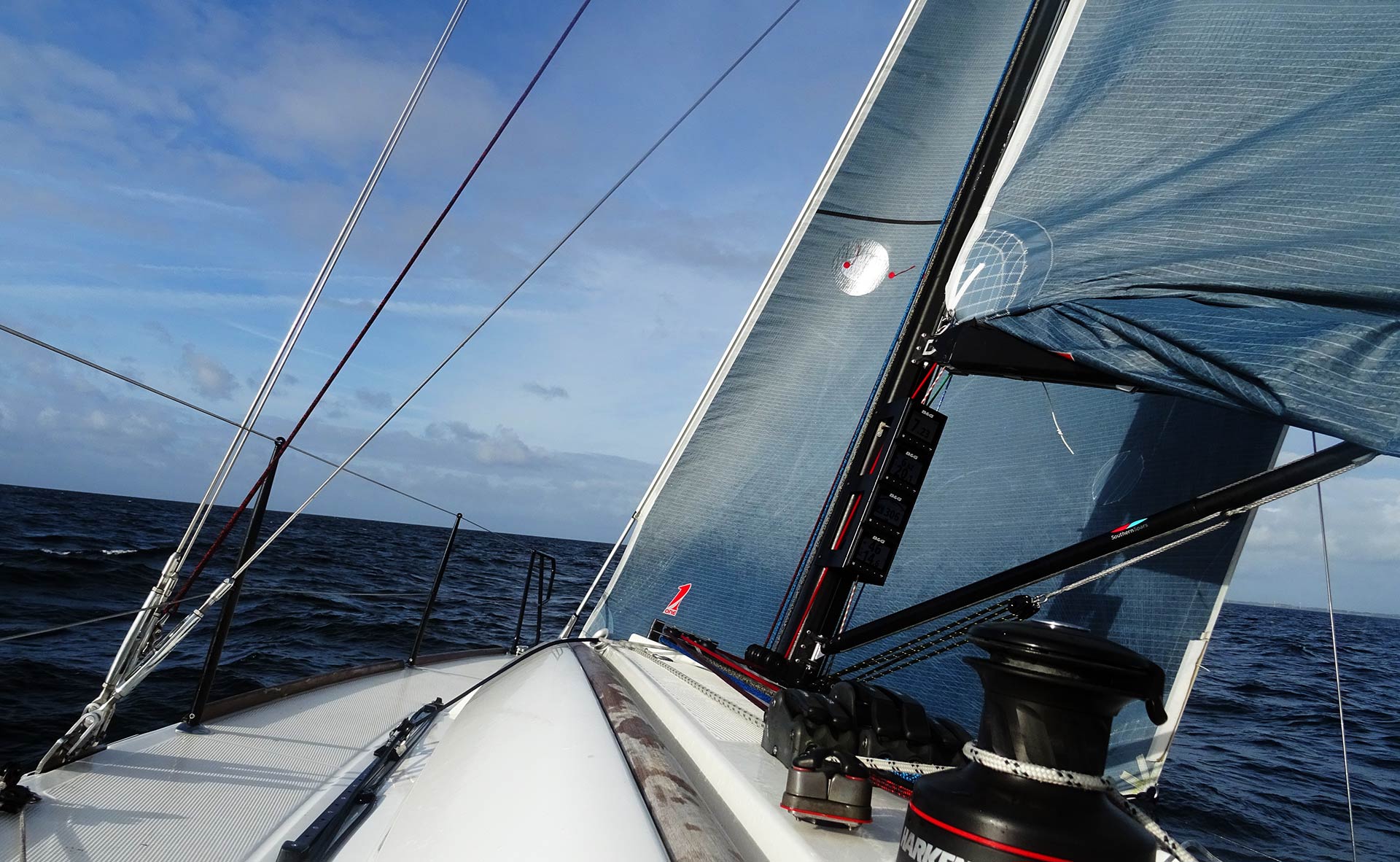
“May I take a nap?”, I ask and he instantly agreed: “Of course my friend, that´s what we are here for, isn´t it?”. For the first time of this sailing trip I could let lose everything, formed a makeshift pillow out of a coil of currently unused sheets and placed myself on one cockpit bench. Closing my eyes, feeling the heat of the sun and being one with the boat´s motion – it was just paradise! I heard to the sound of the waves and the slight sharp noise of our bow cutting the waves, the occasional clapping of our boom and enjoyed the shaking of the boat, the constant left and right when he was adjusting the course of our yacht. Then I dreamt myself away …
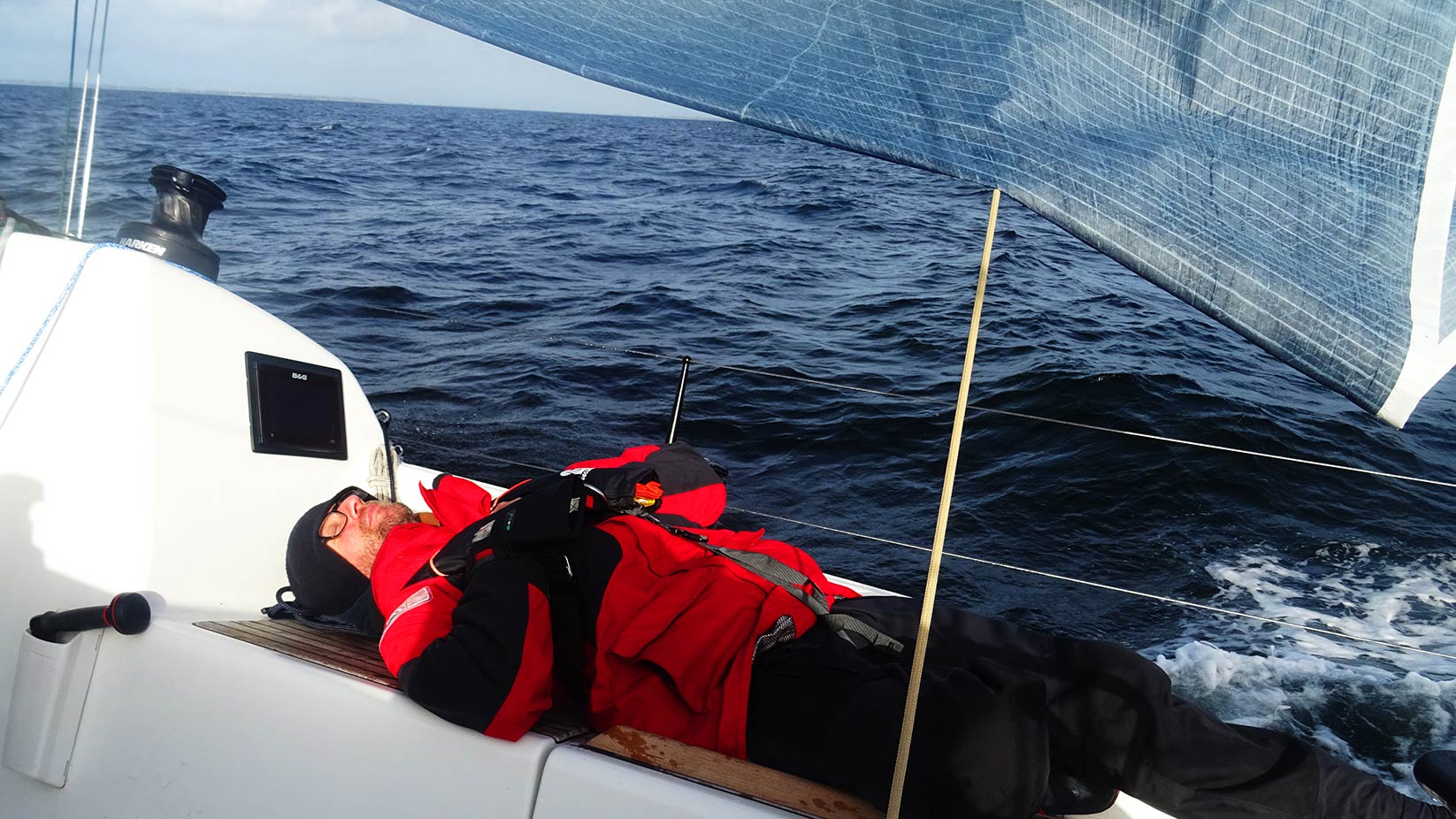
I can´t tell how long I was laying down this relaxed, but I awoke when I felt that something had changed. The sun was gone and the movement of the boat changed to a more abrupt and rockier style. The sky was fully covered in clouds again and when I raised myself to sit on the bench again I noticed that wind had become stronger and seas rougher: “It´s starting!”, my mate said and I knew what he meant.

Checking our progress on the plotter I was astonished of how far North this wind had been blown the boat and how long I must have apparently been asleep. Not far to our starboard side the Island of Aerö was clearly visible. I calculated by using my fingers and emulating a tacking angle of 90 degrees: “Another 5 miles and we can tack to port bow, than it´s just a last leg of some 8 to 9 miles and we´ll be inside the Schlei.” He nodded. But I guess he already had a feeling that we wouldn´t be able to sail all the way down. Weather was worsening rapidly now.
Seeking safe Havens in a Storm approaching
In fact, we had to take down the main completely just minutes afterwards as a very strong hard blowing wind set in, gusting at 28 to 30 knots and constantly blowing at 24 to 26 knots. The worst part was that waves almost out of nothing again built up to 1.50 to 2 metres in height and – worst of all – we had them coming in right dead ahead. We tried just one minute but the hard battering of the boat, the sheer shaking of the whole rigging was putting tremendous strain in the system and we couldn´t risk damage or worse, so we had to tack yet another time to North again to have the waves coming in from a more favourable angle. But still, the boat got beaten nastily and I could tell from looking at my mate´s face that he was really in pain for the boat.
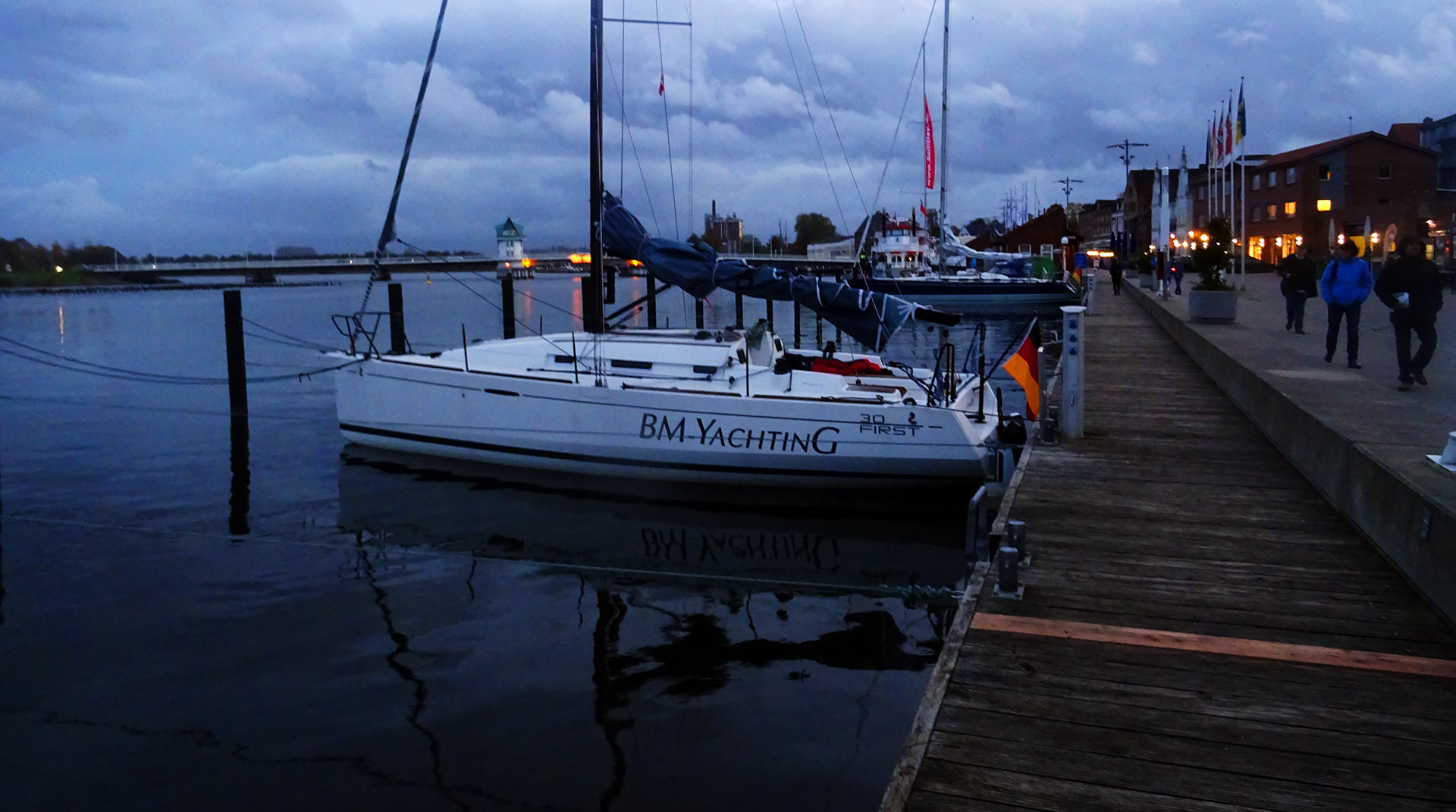
When we finally moored our boat in Kappeln, we had steamed a lot longer and a lot more miles than planned. This time, the change of the weather didn´t came later but sooner as the forecast had promised and again I was stunned of the short period of time the transition of the seas from “hey, that´s pretty nice awesome!” to “bloody stormy hell” in fact has been. We were very lucky having chosen Kappeln as our port because here we had full cover of higher buildings. I just couldn´t imagine now being in a completely uncovered harbour like Ballen …
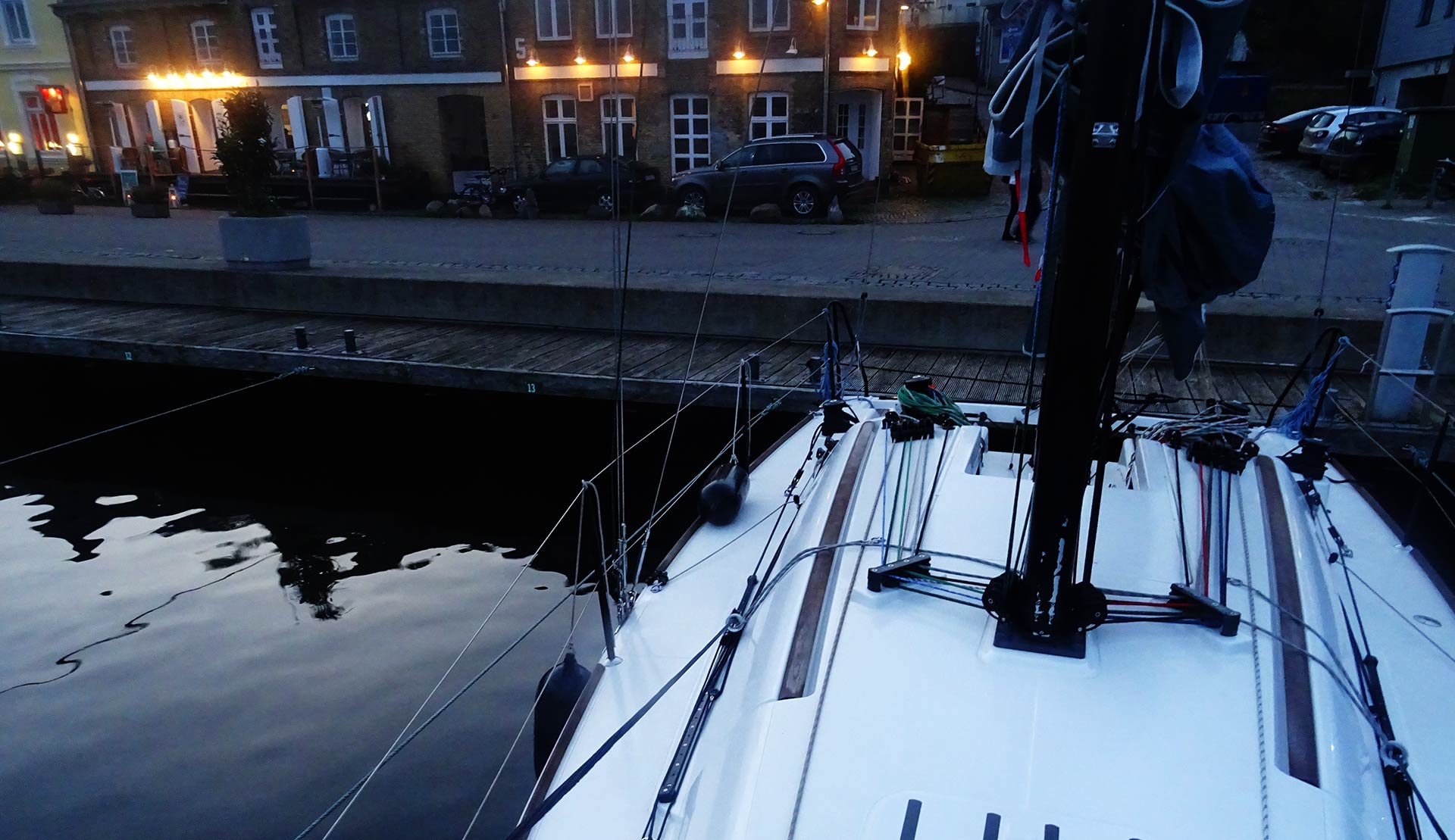
Being in the Schlei again was a pure treat. We decided not to get dressed properly but remained in our sailing cloth. Partially because the showers and other facilities had been closed due to off-season (but we still had to pay full price, welcome to Germany again) and also because we were so hungry, we stumbled into the next best restaurant and I ordered a double serving of traditional Labskaus, which in fact was the first real nice meal for days after we´ve only been eaten simple one-stove-cooked canned food and pasta. Awesome! “Tomorrow we can sleep very, very long.”, my mate was again checking forecasts: There´s a time frame of some 4 hours of easing winds around 2 p.m.. Before and afterwards it´s the same as it is now.” That meant: No getting up at 6. And real breakfast. Wow, a true vacation at last …
Last Minute Call before Hell breaks loose
We couldn´t stick to our bunks the next day too long. There was much traffic going on right behind the jetty and a queue of trucks was constantly unloading food and deliveries to the multitude of shops, hotels and restaurants. At 8 I was up, my mate as well and after the customary toothbrushing action we placed ourselves in the nearest bakery to indulge a hefty breakfast. I drank 6 or 8 large cups of coffee, just because this was the first real coffee for days, my mate was eating fresh apple cake as if we were to cast off on a Round Horn trip. Time went by fast, the last our we were just sitting in the sun. Having a last coffee of course.
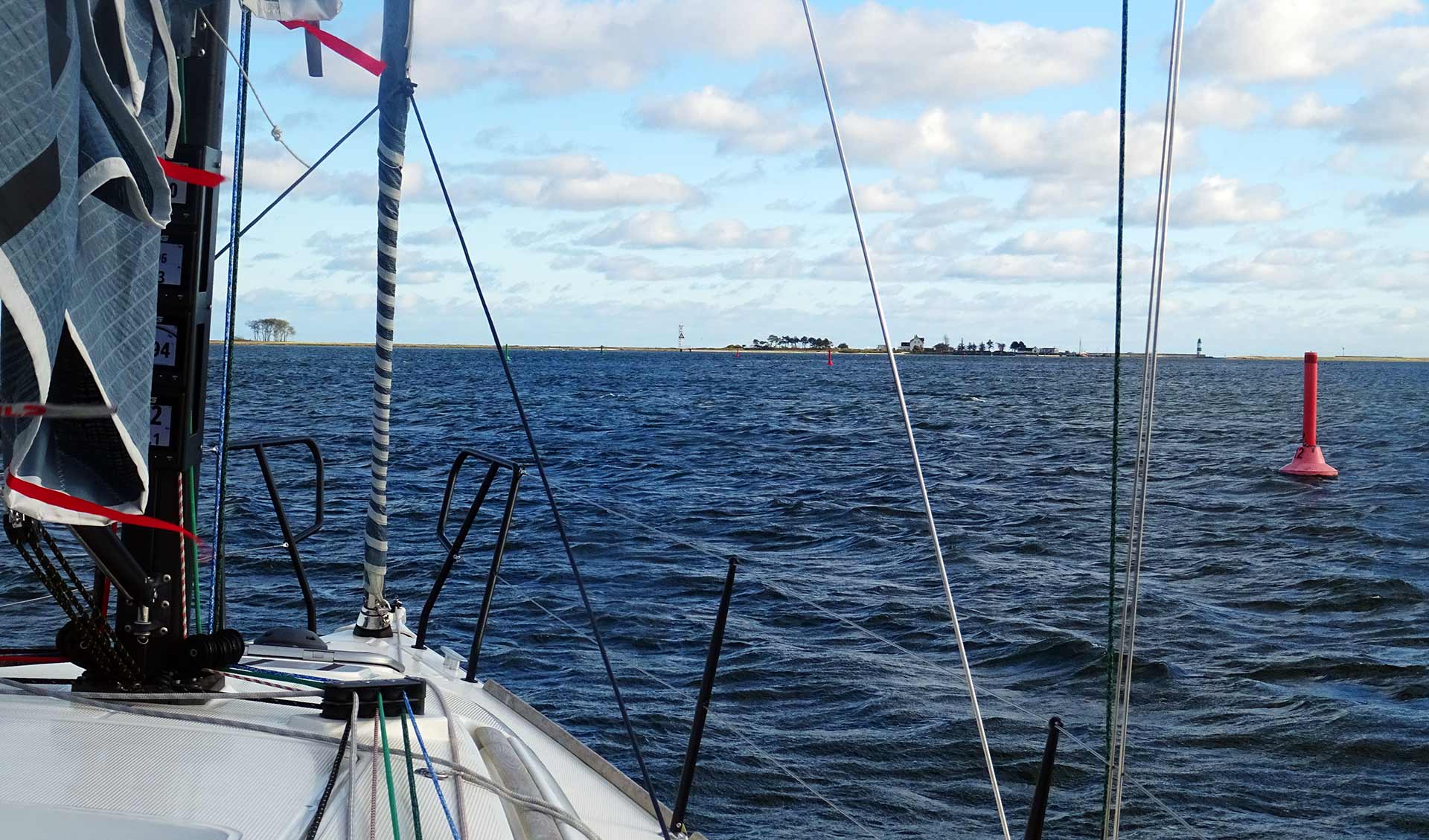
It was time to get underway. As we were steaming down the Fjord, the Schlei for 4 miles I just couldn´t believe that outside this protected landscape a full-fledged storm – later called “Herwart” – was unfolding his brutal reign. “Wait for it”, my mate said, sure of the ride we were to expect in a few minutes. I recalled the situation: A heavy depression was approaching via North Sea and was to cross Northern Germany tomorrow. It´s harbingers had already beaten the land for four days now and this was really the last day for being out on the seas. As we were nearing Schleimünde, the entrance to the Fjord, I could clearly see it: A huge vortex was raging in the entry to the inshore funnel, my mate had to hold tight to the tiller to prevent the boat from drifting off course too much.
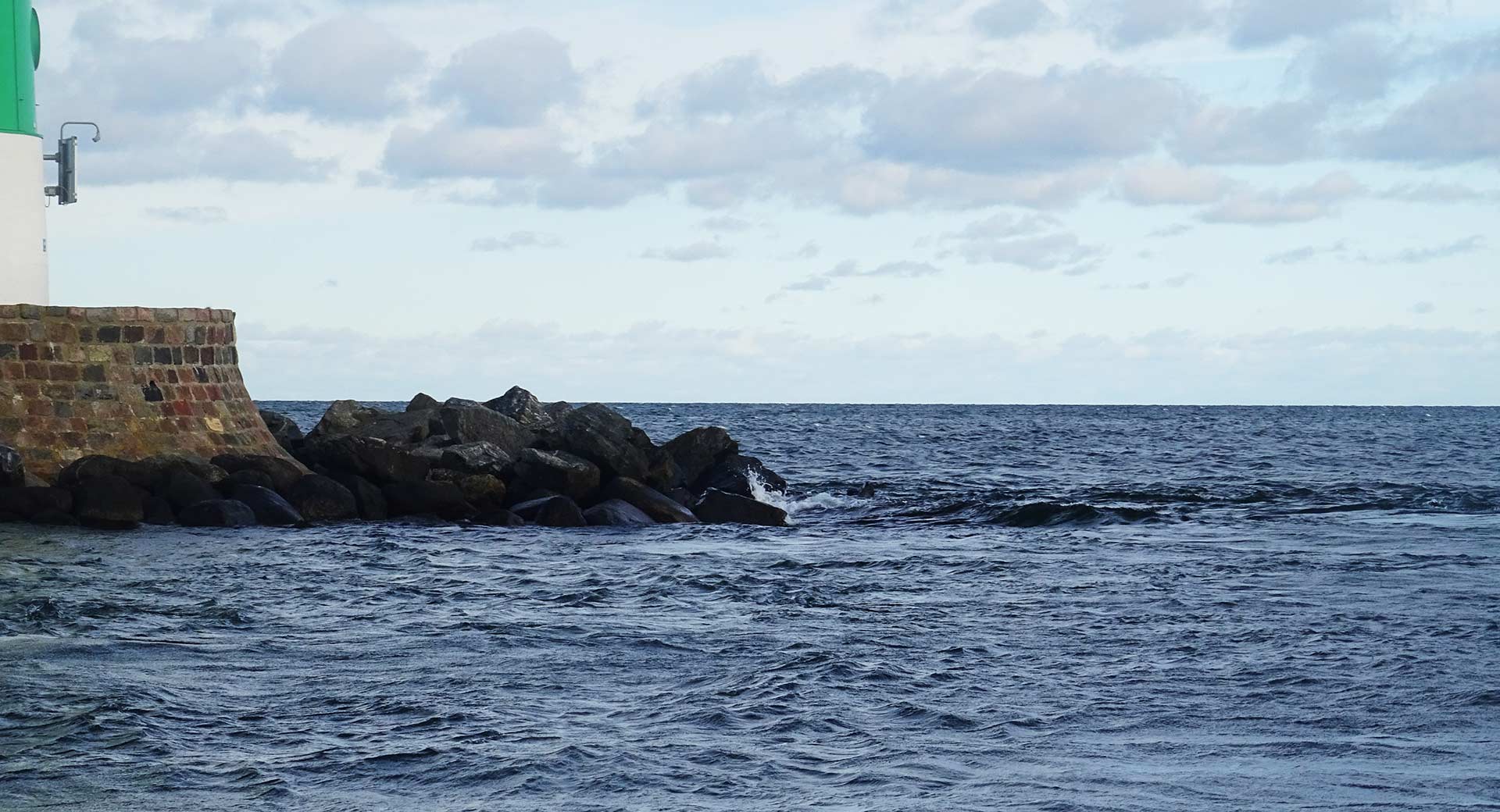
Then it happened as predicted: Winds weren´t blowing from a good direction and we again couldn´t go for the direct course to our final destination, the Flensburger Förde. We had to steer as cuspid to the waves as possible, preventing our little boat from being battered too hard by the ever building waves. Wind wasn´t as strong as yesterday – the time frame of an eased wind of up to 20-22 knots, but still the waves were quite high. Another 6 hours of stubborn running on Diesel, this time even without the stabilizing reefed jib acting as stunning sail since the wind was coming in front dead ahead.
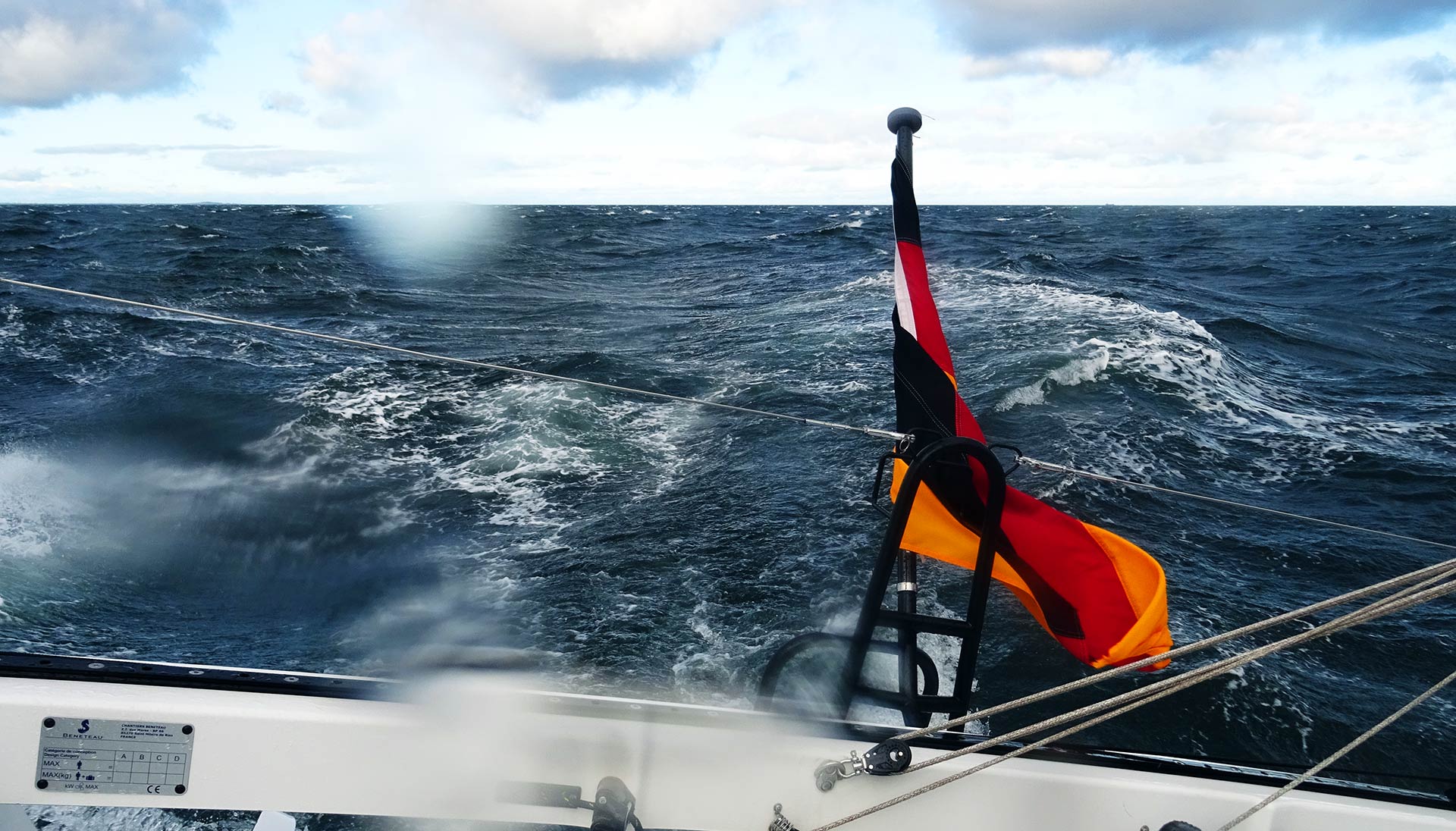
How much strain can a boat take? Not often, but sometimes quite hard our yacht was pitching so hard that I felt the mast shivering afterwards for another second or so. As always, my mate wanted to protect his not-waterproof clothing from being soaked wet and stayed down below in the entryway where he was protected by the spray. I grabbed to the tiller and held my bearing and after three long hours we finally steamed into the promising bay where at the end – still a long way to go – Flensburg was situated. Then the wind came back with full force and we quickly furled I the jib we´ve hoisted in hope of at least trying to sail one single mile or so. It was just too strong and gusty. Meanwhile the sun was coming down again – pretty fast – and then eventually swell died down. It was cold. I was tired. When finally for a last time the cloud cover ripped apart to give way for an almost hysterical dawn we turned the boat a final time to port and steamed upriver the last 4 miles to moor in Flensburg again.
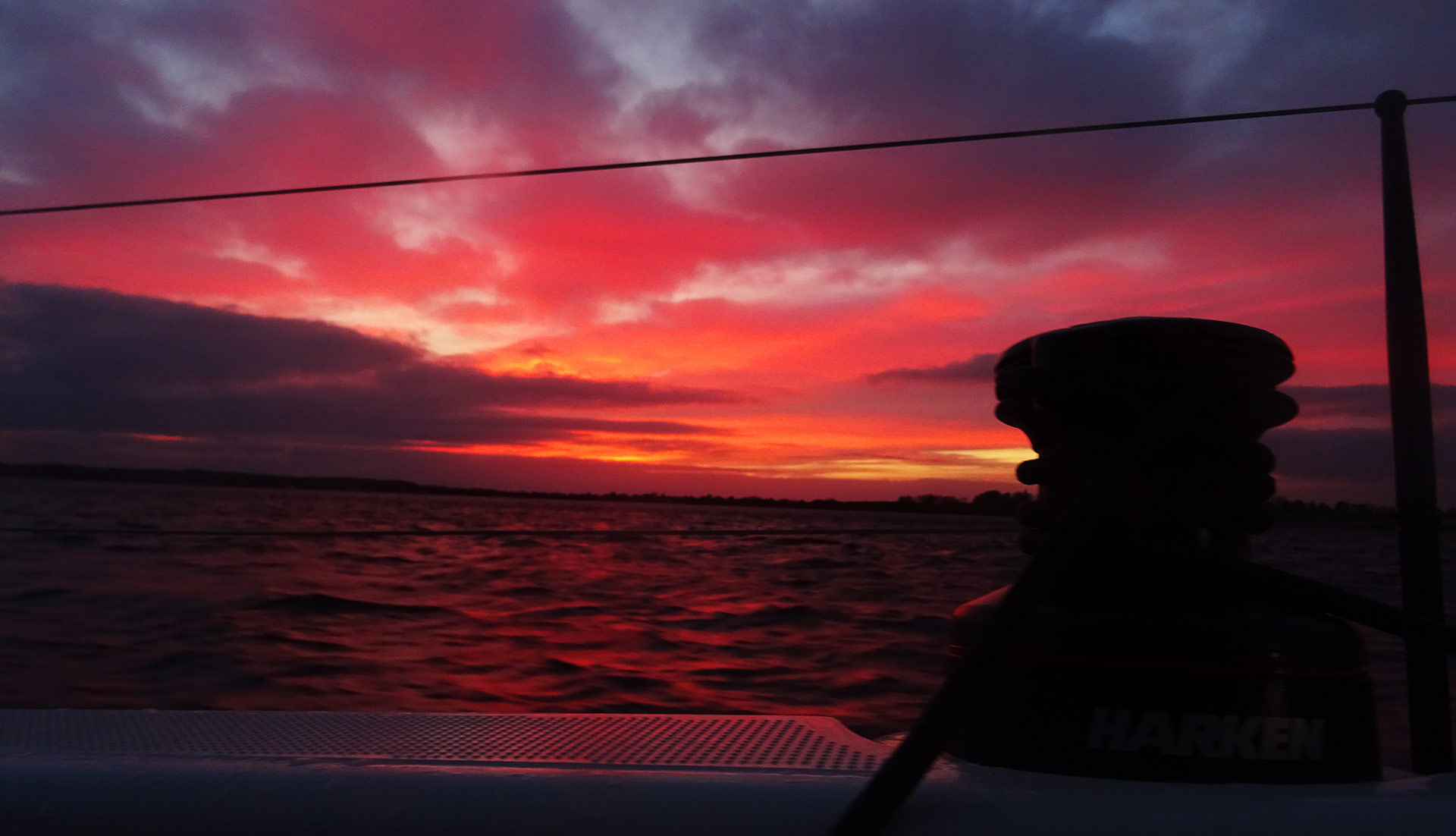
Upon landing, this sailing trip lasted 5 days – instead of the planned full 7 day week. Only 12 hours later one of the severest storms ravaged over Germany, causing the death of people and damage of property worth Millions of Euro. It lasted two full days and brought heavy winds, lots of downpour and chaotic conditions on streets, the Autobahn and trains. Unimaginable to being out there in the seas during Herwarts reign in our small Beneteau. In the end we were lucky having clogged at least 303 nautical miles rounding Fyn in 5 legs. I was happy. Very happy.
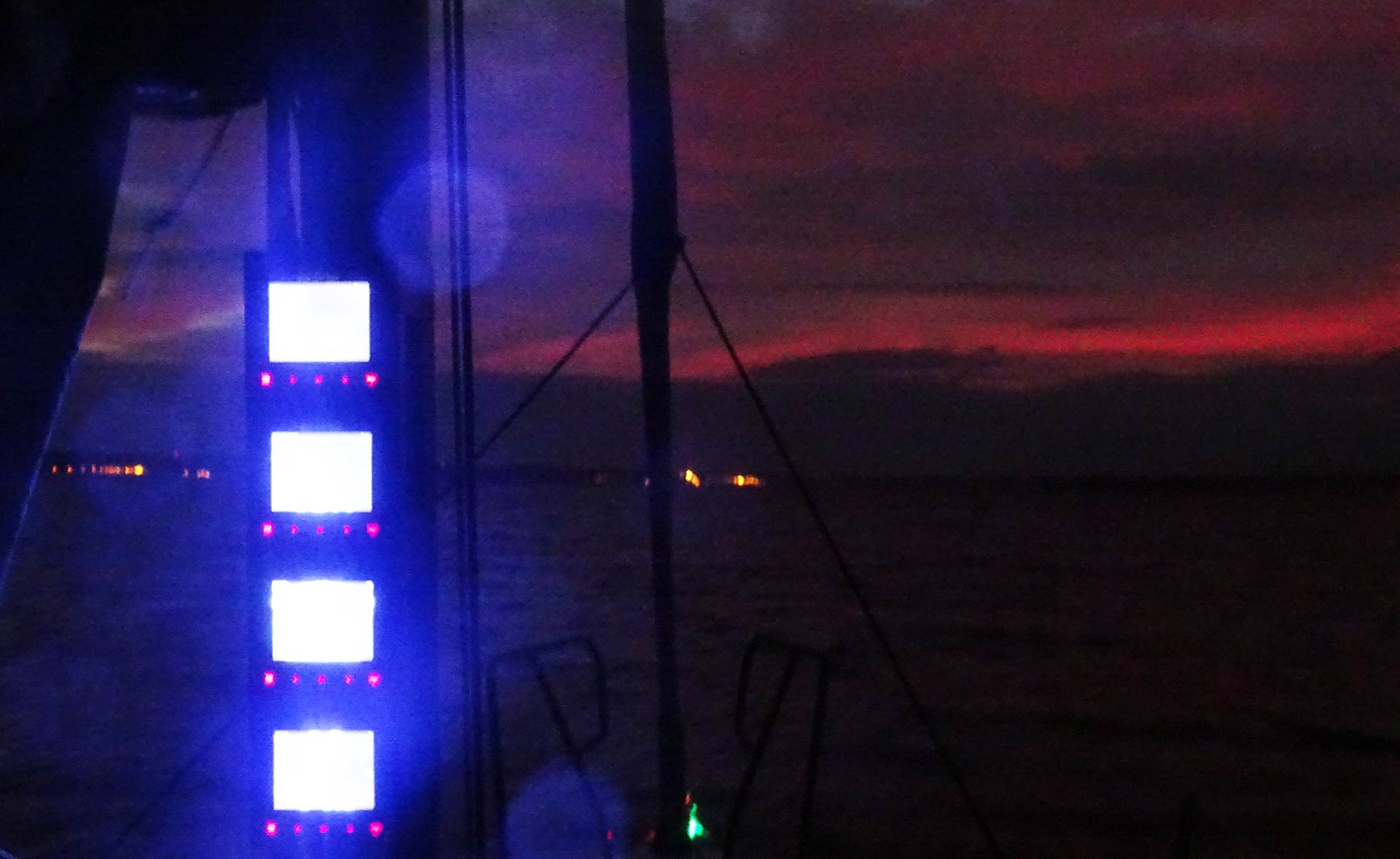
There wasn´t any sorrow about the fact that we didn´t reach the Island of Anholt in the northern Kattegat. I told it my mate this way: “See, I´ve learned more about sailing in harsher conditions during those intense 5 days than during my previous 2.500 miles together. This was a true, thrilling, enlightening and very, very helpful foul weather class for me.” And it really was: I learned a holistic approach to dealing with such conditions from evaluating forecasts, reading charts, passage planning, heavy weather helming, safety measures (including what not to do´s) and had multiple enlightening moments. I was and still am thankful for his time, support and friendship. Calling such a fine sailor one of my friends is a true privilege. “Next time, it´s Anholt!”, I promised as we parted to our daily lives again. And I hope that this next time will be very soon.
You may browse to all Samsö-sailing-related articles by clicking on this hashtag #samsoe
Thanks to BENETEAU-Dealers Enjoy Yachting and BM-Yachting for kindly supporting this trip.
Also interesting to read:
Modern weather routing and passage planning with QTVLM
Old school passage planning
First time skipper of a boat
